Abstract
The triad Cat. 767 in the Museo Egizio, Turin, depicts a king embraced by the gods Amun-Ra and Mut. This statue is inscribed for Ramesses II, but shows traces of repairs and a number of features characteristic of sculptures predating the reign of this king. The authors therefore challenge the commonly held dating and interpretation of the piece. Notably, the article explores the following question: Are we confronted with a monument of the Eighteenth Dynasty, mutilated during the Amarna period, then re-carved and reinscribed under Ramesses II, or is this an original Ramesside production, accidentally damaged and restored? This case study also invites some reflections on the practice of reuse and re-activation of statues during antiquity, as well as on the so-called “usurpation” of monuments.
1. Description of the statue
The triad in the Museo Egizio, Turin, Cat. 767, represents a king seated between the gods Amun-Ra and Mut. It is carved in red granite. Its dimensions are: h. 170; w. 113.5; d. 94 cm. It was sold to the king of Sardinia and duke of Piedmont Carlo Felice in 1824, as part of consul Bernardino Drovetti’s collection, which formed the core collection of the then Regio Museo. Like most of the large statues from the Drovetti collection now in Turin, this triad was found in Karnak by the sculptor and excavator Jean-Jacques Rifaud in 1818.1
Turin Cat. 767. Photo by Pino and Nicola Dell’Aquila / Museo Egizio.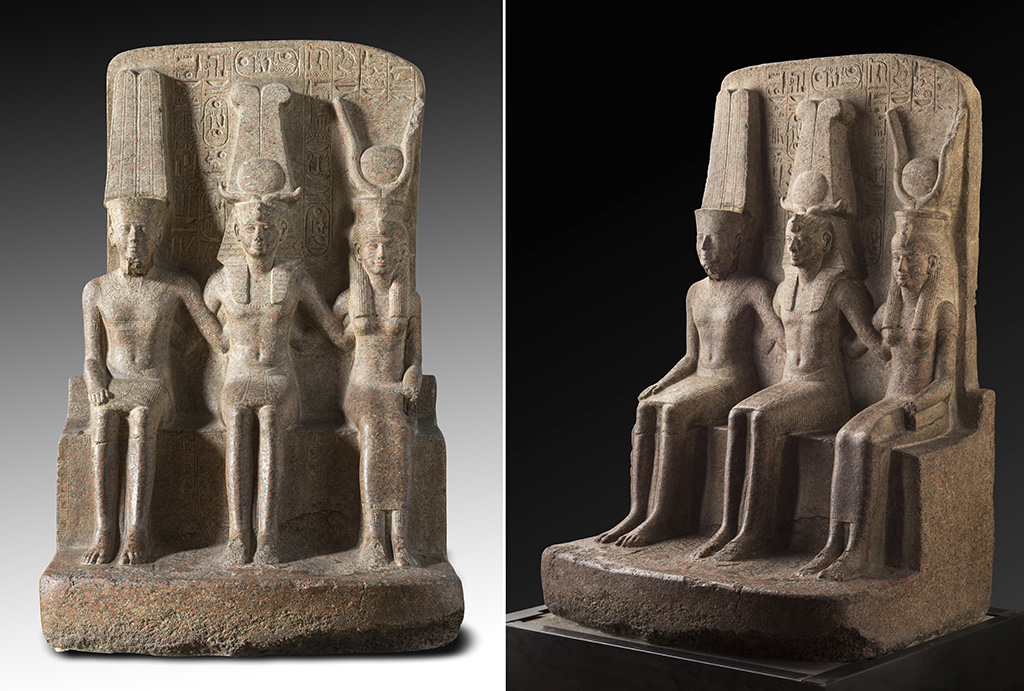
The three figures are represented embraced, seated on a throne with a low backrest, and leaning against a high back slab. The throne is decorated by the Egyptian frieze pattern on the front, on either side of the legs of each figure, and on the sides of the throne, to suggest three individual thrones. The back slab, which is narrower than the throne, is rounded at the top. The base, which has the same width as the seat, is slightly rounded at the front.
The outer hand of both deities lies flat on the knee, while the fingers of the inner one protrude from behind the opposite shoulder of the king. The king’s hands emerge from the back slab to rest on the respective shoulders of the deities.
The god Amun wears his characteristic headgear, a crown surmounted by a pair of high feathers. He
Head of Amun (Turin Cat. 767, detail). Photo by Pino and Nicola Dell’Aquila / Museo Egizio.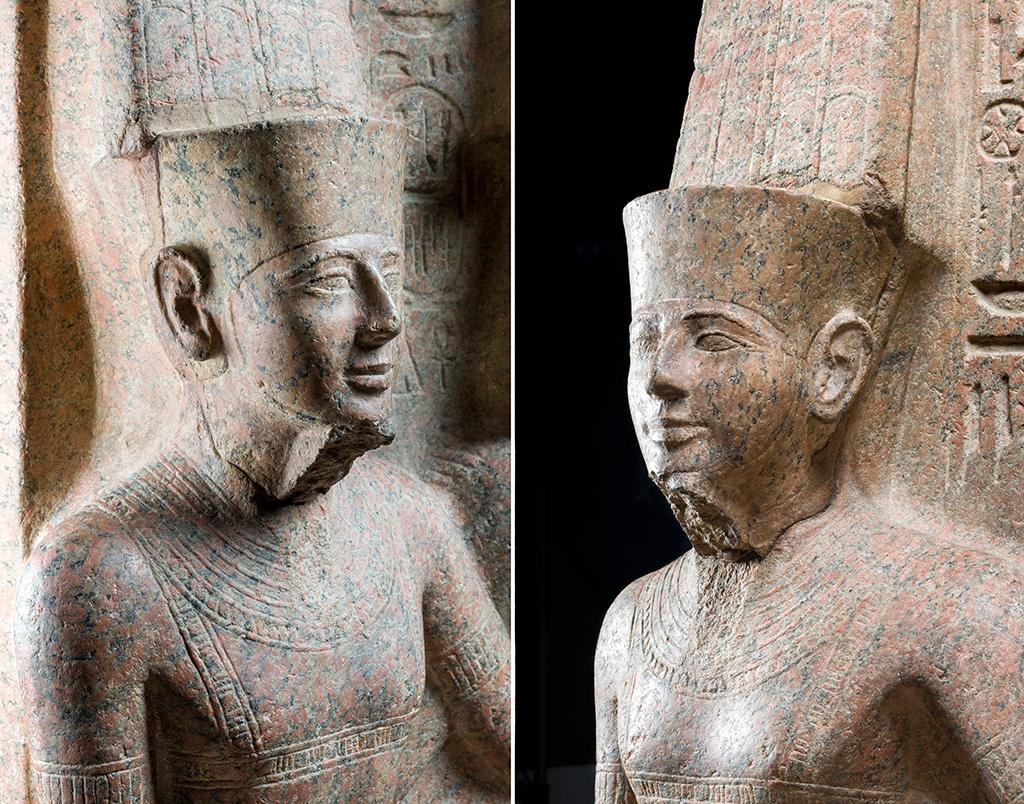
Knees of Amun (Turin Cat. 767, detail). Photo by Pino and Nicola Dell’Aquila / Museo Egizio.
Mut’s arm (Turin Cat. 767, detail). Photo by Pino and Nicola Dell’Aquila / Museo Egizio.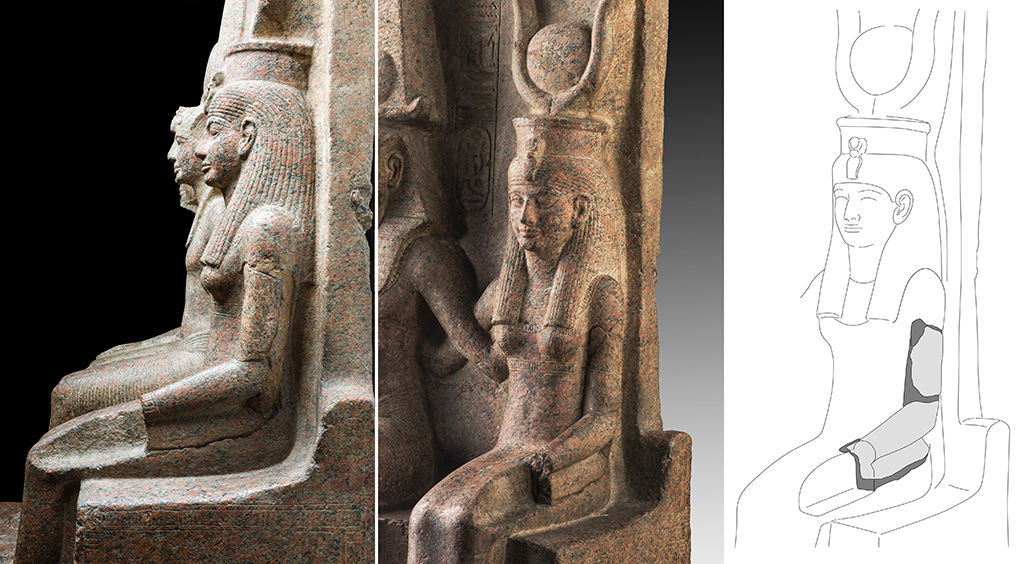
The goddess Mut wears the traditional sheath dress with borders and straps decorated with a frieze pattern. Her long tripartite wig is topped by the canonical crown of Isis and Hathor: a modius and a lyriform pair of cow’s horns enclosing the solar disc.
Seated between the two deities, the king is dressed in a ceremonial kilt with a striated front-piece terminated by six pendants which are flanked by two uraei. Above the nemes, the king wears the henu-crown, composed of a solar disc and two ostrich feathers mounted on a pair of twisted ram horns.2
Each of the three figures wears a wesekh-collar composed of five undecorated bands and a row of drop-shaped pendants. Striated bracelets adorn the arms of Amun, as well as the proper left wrist and the ankles of Mut.
An inscription in six columns is carved on the front face of the back slab, in addition to a horizontal cartouche above the king.
Inscriptions on Turin Cat. 767. Drawing: S. Connor.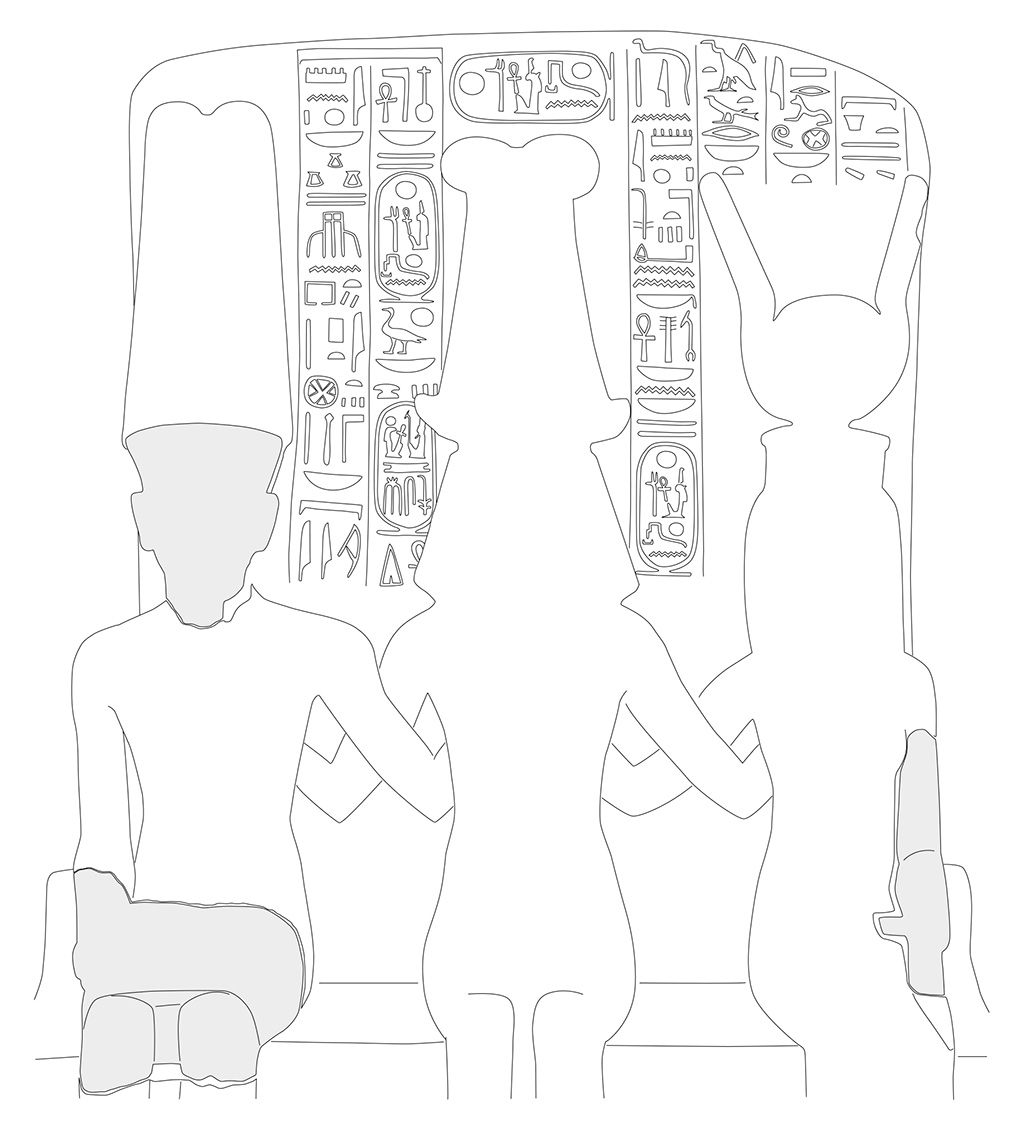
Inscriptions
Above the king ←
“Usermaatre-Setepenre”
Between Amun-Ra and the king ←↓
“1 The perfect god, Lord of the Two Lands, Usermaatre-Setepenre, the son of Ra, the lord of crowns, Ramessu-Meryamun, given life,
2 ↓→ beloved of Amun-Ra, lord of the thrones of the Two Lands, foremost in Ipet-Sut, the great god, lord of the sky.”
Between the king and Mut
“1 Words to be said by Amun-Ra, lord of the gods: ‘I gave you every life, stability and strength, to the Lord of the Two Lands, Usermaatre-Setepenre.’
2 Mut the Great, Lady 3 of Isheru, Lady of 4 the Sky, Mistress of the Two Lands.”
2. State of preservation
The statue is almost complete. Only the proper left hand of the goddess and the beard of Amun are missing. The feet of the king and of Mut are damaged. The face of Amun, his knees, and Mut’s proper left arm consist of separate pieces of granite integrated into the main block. These repairs will be discussed below.
The sculpture was restored in 1991 at the G. Nicola Laboratories in Aramengo (Piemonte, Province of Asti). Until then, the surface of the statue was very dark. According to the restorer,3 this black appearance was due to dust and a black oily film that darkened the red granite’s surface, an effect which he attributed to a nineteenth-century treatment of the statue. He detected old integrations of poor-quality plaster, as well as oil painting on Amun’s legs and Mut’s left arm, which are compatible with a nineteenth-century restoration.4
The 1991 restoration consisted mainly of mechanical cleaning and treatment of the nineteenth-century chromatic integration by tone rendering with Liquitex, specifically on Amun’s knees and further down, near the modern cement base.
This cleaning process revealed colour in some areas, specifically on the skin, the shendjyt-kilt (white), and the feathers of Amun.
3. History of the piece
The statue is registered as having been found in Thebes in 1818 by Jean-Jacques Rifaud, one of the agents of the French consul Bernardino Drovetti.5 Rifaud was in charge of collecting statues on the East Bank of Thebes and carved his name and the year of discovery on the back of the statue. Determining the specific location of the statue in Thebes is still a work in progress, but we have traced some important information.
The statue can be identified in the “Catalogue de la collect. d’antiq. de mons. le chev. Drovetti”, written in 1822, as number 35 (“Statues” section): “Trois divinités en granit rouge”.6
This triad is traceable in two different handwritten lists in Jean-Jacques Rifaud’s memoirs held in the Bibliothèque de Genève. As a study of his manuscript pages has borne out, we know that Rifaud worked for a long time inside the temple of Karnak in Luxor. In the first list, we read :7
21 I bas relief de trois divinites en granit rose representant hourus isis et hosiris d’une conservation parfaite d’un tres beau style et d’un superbe fini enrichi de caracteres hyerogliphiques d’un grande dimension de position asises … 12.000
In the second, more synthetic list, there is an interesting piece of information:8 « 20 le barelief des 3 divinite en greni rose 12000 ». The number 12,000 refers to the cost in Egyptian piastres, a currency of the time in which most of Rifaud’s economic transactions are registered.
The year of discovery, 1818, was the most profitable period for Rifaud, during which he found several works currently held in Turin. We can still read in his written memories a description of the wealth of discoveries made at the time (Fig. 6):9
(…) javais quelques fonds a moi et je les enployä [employa] pandants un mois e demi sans
Page from the memoirs of J.-J. Rifaud. Bibliothèque de Genève.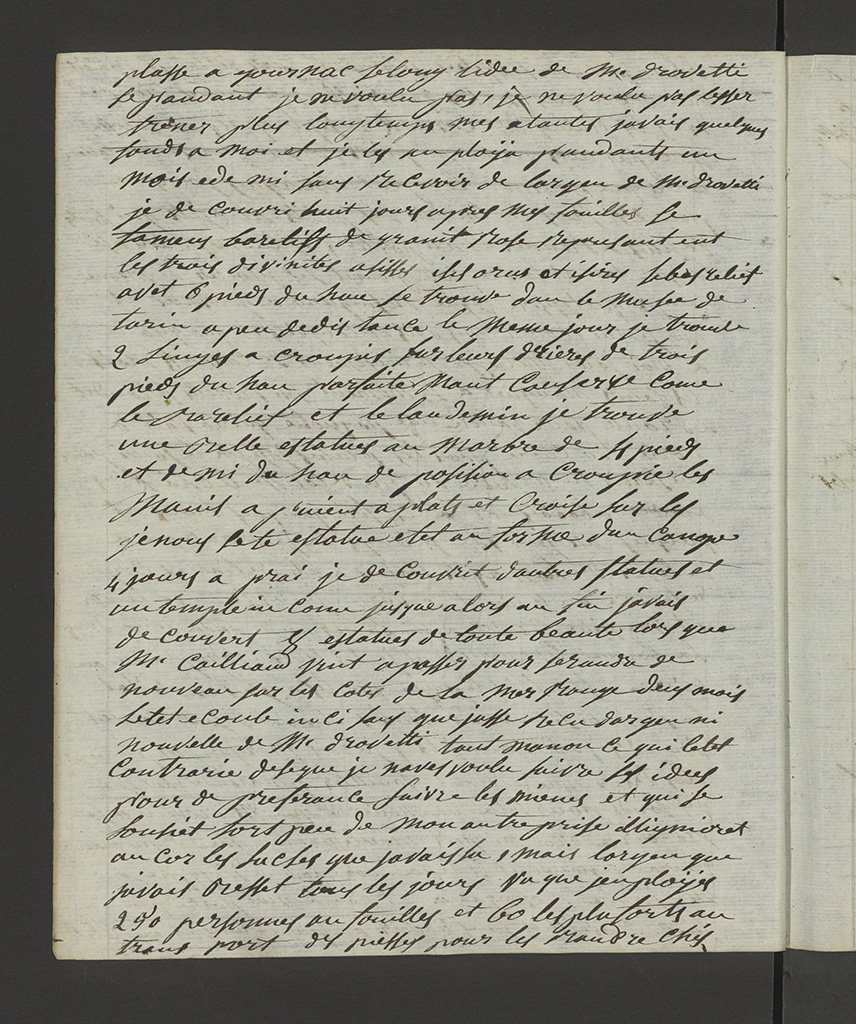
The excavations in this area were thus very successful.10 Rifaud also found other statues besides those mentioned above.11 In the same pages of his memoirs, he adds that he had 250 people working for him at the time.
Following years of excavating in Egypt, Rifaud wrote and published a book titled Tableau de l’Egypte, de la Nubie et des lieux circonvoisins ; ou itinéraire a l’usage des voyageurs qui visitent ces contrées, a text that offers such a wealth of information that it can be regarded as a true travel guide.12 This work was enriched by 250 plates, which were published in fascicles from 1830 onward, over a span of about twenty years.
In the explanatory captions for the drawings in his Tableau de l’Egypte, Rifaud indicates the eastern area of Karnak as the place where he discovered some important statues, some of which are clearly recognizable as works in the collection of the Egyptian Museum in Turin. Among these drawings, we also find triad Cat. 767, on plate 47, captioned
In the same text, a report summarises Rifaud’s discoveries in Egypt. In its mention of the eastern area of Karnak, the text refers to the sector outside “the great temple or palace”. Therefore, the place of excavation of the statue is probably the eastern part of the large enclosure of Amun, an area that we can assume was excavated by Rifaud during the year 1818. It is most probably the temple of Amun-Ra-Harakhty or Amun-Who-Hears-Prayers, which lies east of the great temple of Amun-Ra, along its axis (Fig. 7). Since it is poorly preserved, only aerial photos allow us to recognize and understand the temple of Amun-Who-Hears-Prayers as a whole. This structure was erected in the Eighteenth Dynasty, then rebuilt by Ramesses II and subsequently completed during the Twenty-fifth Dynasty. It is built against the back of the main temple and oriented in the opposite direction. Functioning as a complement to the main temple’s cultic activities, which were inaccessible to the common man, this “contra-temple” seems to have been devoted to personal piety, allowing more direct contact between the human and the divine worlds.13
East temple of Karnak. Photo: S. Connor.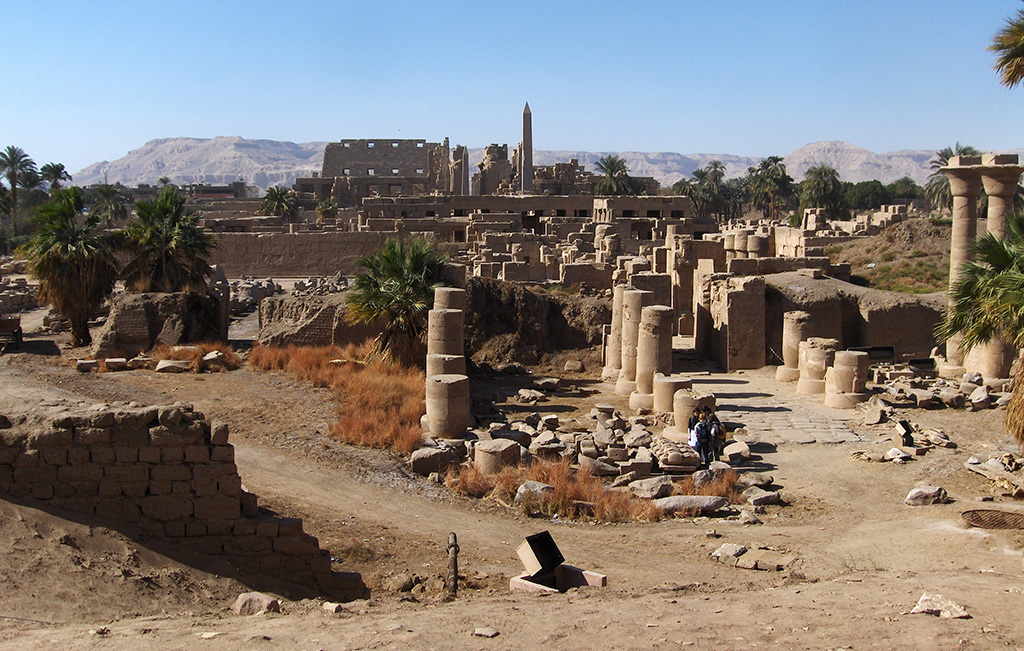
If the Turin triad was really found among the ruins of this eastern temple, it is likely that it was visible to a relatively large number of people – at least more than if it had stood within the walls of the main temple. The sculpture may therefore have been one of several intercessor-images between the worshipper and the gods, as could be expected in a “contra-temple”. Although the rest of the statue is in a relatively good state of preservation, the upper surface of
Upper surface of the base of triad Cat. 767. Photo by Pino and Nicola Dell’Aquila / Museo Egizio.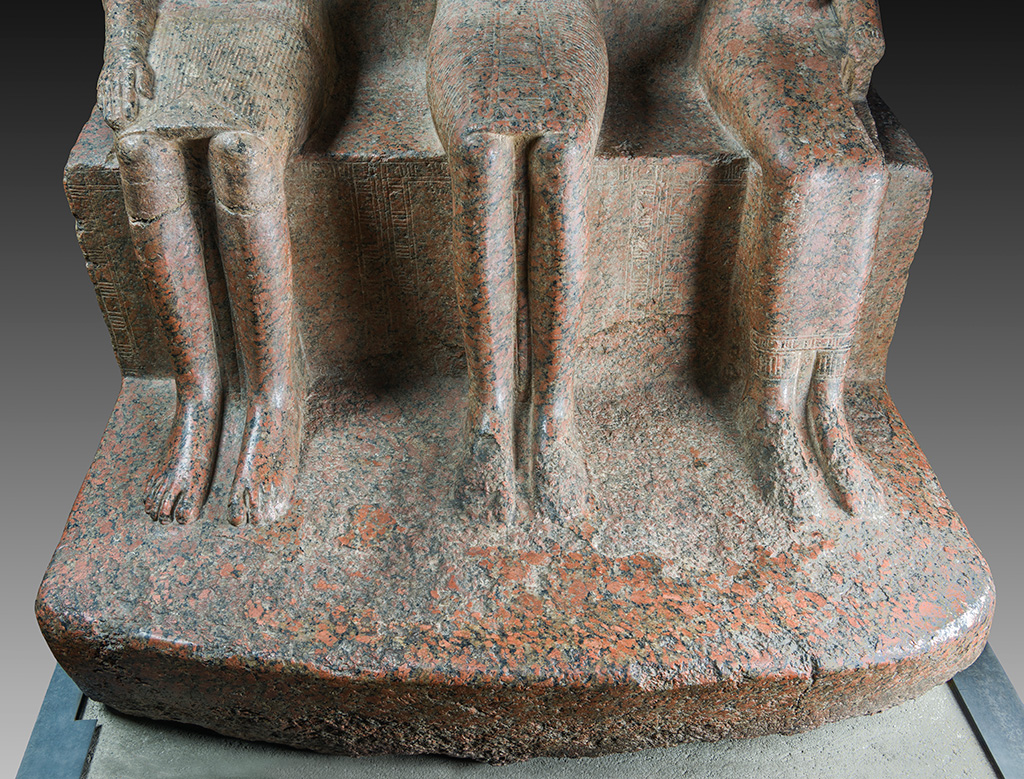
4. Style, typology and interpretation
At a certain distance, the group shows elegant and harmonious proportions. However, the art historian may feel somewhat intrigued when contemplating the faces up close, as they show some irregularities in treatment and in the quality of their carving. Even though the treatment of the bodies, clothes, crowns and ornaments is well balanced and of fine quality, the faces are less elegantly proportioned (particularly in the profile view). Of course, a specialist may use her/his eye and “gut feeling” in the first instance, but hard evidence for either authenticity or forgery, or for a precise dating, should be sought, and all possible objectivity deployed.
Some areas on the faces of the king and of the goddess display irregularities in the smoothness of their polishing compared to the rest of the surface. This could be interpreted as a sign of re-carving of a pre-existing statue. The surface around the eyes is rougher than that of the cheeks, as is the area surrounding the mouth. However, the polishing of the whole of the statue’s surface was not very carefully done, so these differences in polish do not seem to be a sufficient argument for re-carving. Analysing a portrait of Ramesses II is not the easiest task, not because we lack representations of the king – who is by far the most frequently attested in the repertoire handed down to us – but because of the diversity of their styles. Several reasons may be at the origin of these stylistic differences: chronological, since his reign spanned 67 years, i.e. three generations, or geographical, as this variety may reflect diversities between local productions or ateliers, whether permanent or not. Another factor may be the individuality and skill level of the sculptor(s). The size of a statue also has an impact on its appearance,15 as does the material it is made of – each requiring specific tools and techniques. These criteria, considered individually or combined, show the complexity of a stylistic approach to a statuary corpus. Typology also influences the style and iconography of a statue.16 Group statues, for example, often show some rigidity and a flatter appearance, partly because the sculptors were probably hindered in their work by the very character of the piece, which they ended up treating more as a high relief than a sculpture in the round. Finally, given the great number of statues bearing the name of Ramesses II that are actually earlier sculptures, ranging in date from the Twelfth to the Eighteenth Dynasties, whose style was modified in order to “Ramessize” their features, we are sometimes confronted with royal faces bearing alterations or of unusual proportions, due to retouching by a sculptor.
The examples gathered below illustrate this diversity among the portraits of Ramesses II. Statues in granite and granodiorite that are approximatively life-sized show quite consistent features (Fig. 9). However, colossi in other materials differ in quality and style (Figs. 10, 11). As mentioned above, many reused works from previous dynasties were re-carved for Ramesses II, a good example of which is a mid-Eighteenth Dynasty statue now in Turin (Cat. 1381, Fig. 12). These statues therefore often display stylistic features of both periods combined. Other statues show unusual proportions and seeming marks of re-carving, which have led some scholars to suggest that they were reused from an earlier reign – probably that of Amenhotep III (Fig. 13) – but this is still under debate.17 Fig. 14 show some close-ups of group statues.
a: Turin Cat. 1380. From Karnak. Granodiorite. H. 196 cm. Photo by Pino and Nicola Dell’Aquila / Museo Egizio.
a: Tanis (on display in front of Sheshonq III’s gate). Quartzite. H. 248 cm. Photo MFFT / H. Sourouzian.
Left: Head of one of the standing colossi in front of Luxor temple’s pylon (eastern tower). Granodiorite. H. head: 110 cm. Photo: S. Connor, courtesy of Luxor Inspectorate.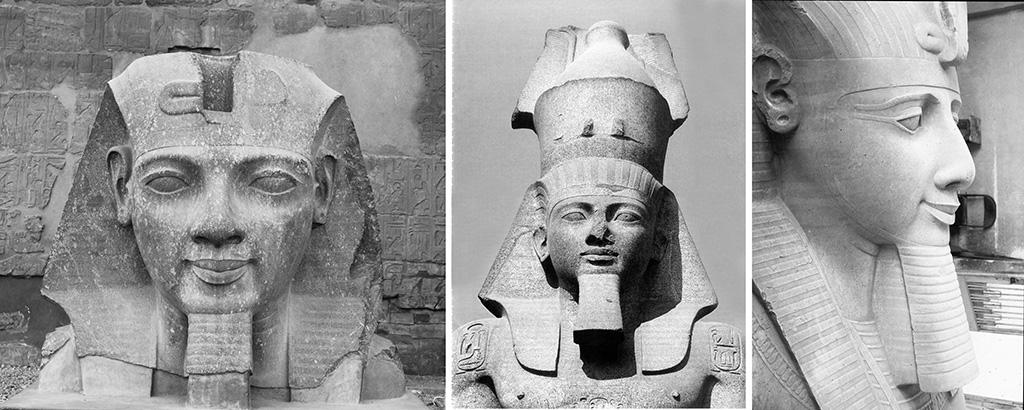
Turin Cat. 1381. Statue from the Eighteenth Dynasty (probably Thutmose III or Amenhotep II) re-carved and re-inscribed for Ramesses II. From Karnak. Granite. H. 220 cm. Photo by Pino and Nicola Dell’Aquila / Museo Egizio.
Left: Cairo JE 67097. From Tanis. Granodiorite. H. 210 cm. Photo Egyptian Museum, Cairo / S. Connor.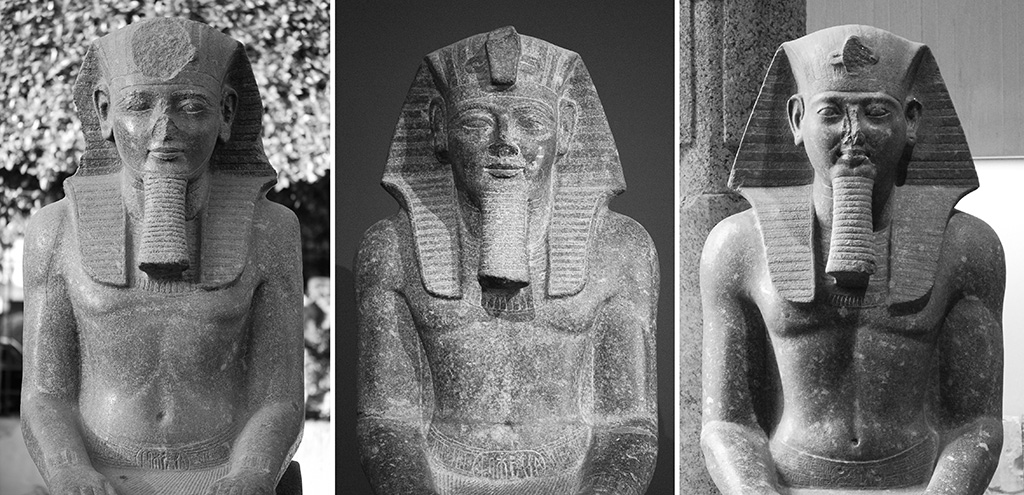
a: Figure of Sety I in the group statue in Abydos, temple of Ramesses II, associating both kings with Osiris, Isis and Horus. Granodiorite. H. 194 cm. Photo: S. Connor, courtesy of Abydos Inspectorate.
Among this huge repertoire, we observe a series of recurrent features in Ramesses II’s depictions.18 The eyes are almond-shaped, wide apart and surmounted by thick upper eyelids. The nose is aquiline. The cheeks are full. The corners of the mouth are raised and sunken, giving the impression of a smile. Slight nasolabial furrows are suggested by modelling, descending from the nostrils, while two other slight furrows start from the corners of the lips and lead
In contrast with these common features, many details vary: while the contour of the face is usually a regular oval, the ratio between its height and width varies greatly. The area above the eyes can be deeply sunken, bringing out the bone structure of the arches of the eyebrows; sometimes, however, this space is sculpted very superficially. The mouth is generally small and curved in a somewhat artificial smile, but in some cases it is wider and more horizontal.
The nasolabial folds may be more or less accentuated, as can be those descending from the corners of the mouth. The eyes and eyebrows are most often underlined with a thick cosmetic line, but in some specimens they are not.
The same variety applies to iconographic elements, such as the pattern of stripes on the nemes, which vary within the corpus of Ramesses II. The most common pattern is a succession of regular stripes, alternatively in relief and sunk, as in the case of the Turin triad under study here. The surface of the sunken stripes is often left rougher, probably to facilitate the application of paint or gilding. In several examples, possibly earlier in the reign, the lappets are finely pleated, as they generally are until the reign of Sety I.
The Turin triad shows most of the features of a Ramesside portrait, although their treatment is not the most representative – perhaps not of the highest level of craftsmanship. The nose is very straight, instead of being aquiline. The upper lip is exceptionally receding, and the mouth is unusually large and fleshy. These features possibly reflect an inferior quality of execution of the faces, rather than a stylistic anomaly.
Profiles of Ramesses II, from statues Turin Cat. 1380 (left) and Luxor Museum CG 824 (right). Drawing: S. Connor.
Profiles of Amun, Ramesses II and Mut in triad Turin Cat. 767. Drawing: S. Connor.
With the proper lighting, clear scars surrounding the god’s face and knees, as well as the goddess’ left arm, indicate that these three elements are made
As we shall see, a number of features observable on the statue belong to the Ramesside period. Nevertheless, some anachronisms, together with the fact that the statue was apparently restored in antiquity, speak in favour of an earlier period. In this case, the statue would have been adapted to fit the style of the Nineteenth Dynasty. An alternative, although less probable, interpretation would be that the statue was produced during the reign of Ramesses II, was damaged, possibly accidentally, and repaired soon after. If this were the case, the iconography adopted for this group, of Tuthmoside inspiration, would be reminiscent of earlier sculptures and could therefore be considered to be archaizing.
Non-discriminatory characteristics
1) The nemes is graced with a pattern of regular stripes, alternately in relief and hollowed out, with an inner edge on the lappets. This treatment of the nemes could fit with a pre-Amarna, post-Amarna or Ramesside dating. Although more frequent in the Ramesside period, it is not rare before it.
Cairo JE 36651 – CG 42097. Triad showing Tutankhamun between Amun and Mut. Limestone. H. 86; W. 115 cm. Photo Egyptian Museum, Cairo / S. Connor.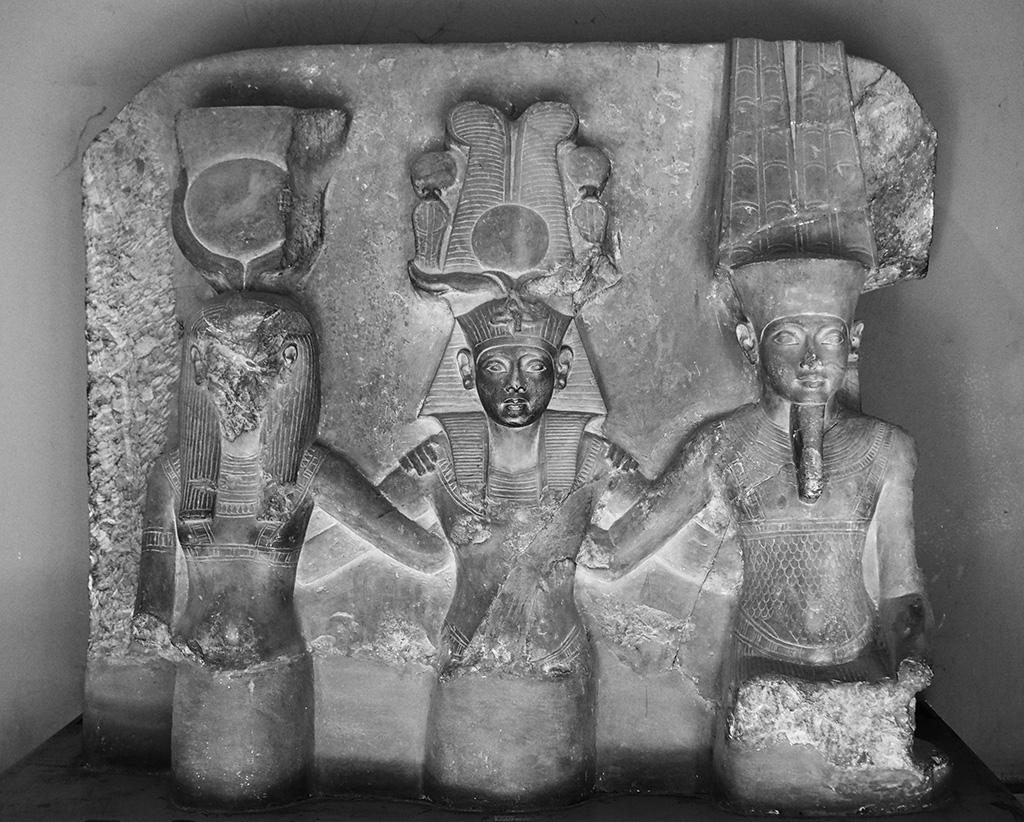
2) The henu-crown above the king’s nemes is composed of two twisted ram horns topped by a solar disc and a double ostrich feather (Fig. 14c). This detail would favour a pre-Amarna dating. In royal statuary, the henu-crown with the disc is flanked by two uraei in the post-Amarna period (e.g. Tutankhamun, Cairo JE 42097 [Fig. 17]; Horemheb, Cairo JE 49536)20 and in the Nineteenth Dynasty, as for example in one of the standing colossi of the small temple in Abu Simbel, the heads of standard-bearer statues Cairo CG 636 and JE 45193, Copenhagen dyad ÆIN 1483, as well as two of the statuary groups carved in the rock temple of Ramesses II at Gerf Hussein.21 The crown appears without this pair of uraei on statues of the mid-Eighteenth Dynasty (dyad of Amenhotep II [?] and Amun, Cairo CG 42065 [Fig. 29]; triad of Thutmose I restored by Tutankhamun, Cairo CG 42052 [Fig. 28]). Nevertheless, two Nineteenth Dynasty attestations of a henu-crown without uraei can be found: one in the figure of the deified Sety I in the statue group in the temple of Ramesses II in Abydos (Fig. 25),22 the other in a triad at Mit Rahina (Fig. 23). Consequently, this criterion is not absolute. The henu-crown, usually a divine attribute, is not frequently shown on royal figures. Therefore, the king’s figure may appear here as a divine figure, greeted by the gods as their kin.
Turin Cat. 767. Photo by Pino and Nicola Dell’Aquila / Museo Egizio.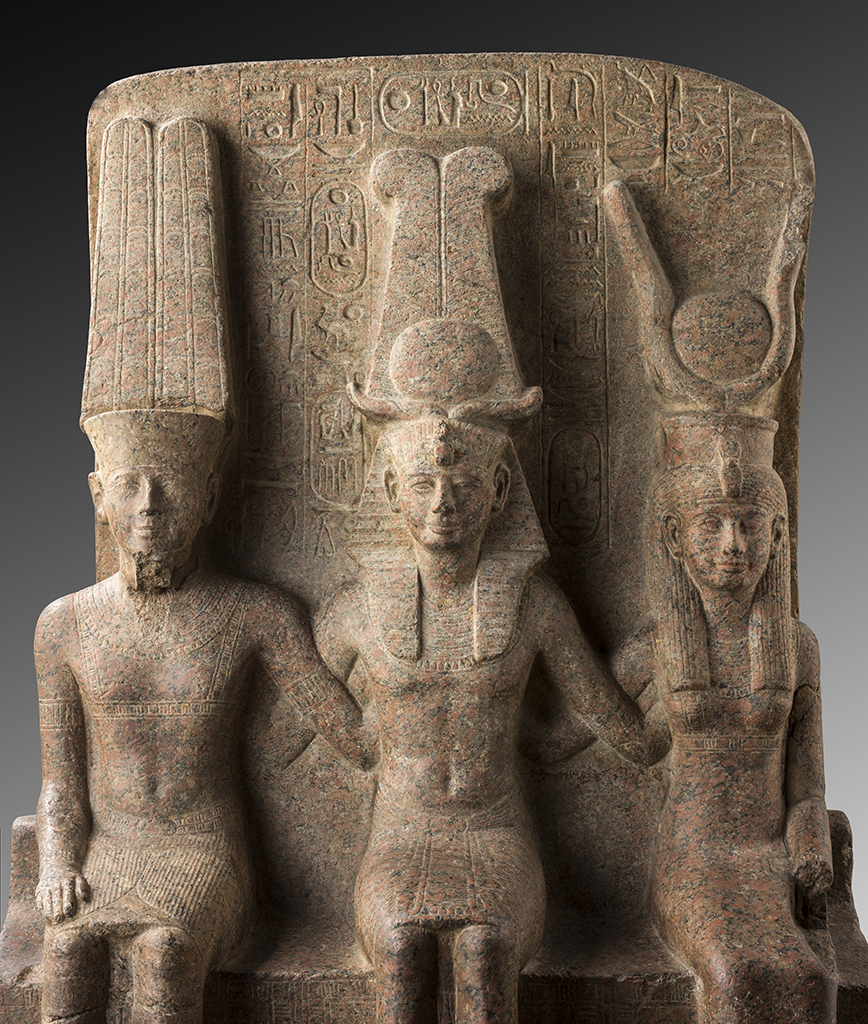
3) The goddess is dressed in a tight-fitting sheath with narrow straps covering her breasts (Fig. 19). In the Amarna period, this type of sheath dress is replaced by the loose, flowing and fringed clothes that will remain in vogue under the Ramessides for queens in two-dimensional and some three-dimensional representations,23 while the traditional tight-fitting dress is retained for figures of goddesses, as it is in this case. The straps, as well as the upper and lower hems of the garment, show a band with a “ladder” motif, which M. Müller defines as a Leitermuster,24 and which we could also call a “frieze pattern”. The same motif adorns the upper hem of the corselet and the straps (also covering the nipples) of the god Amun in the Turin statue. These straps, which can either cover the breasts or
Turin Cat. 767 (detail). Drawing: S. Connor.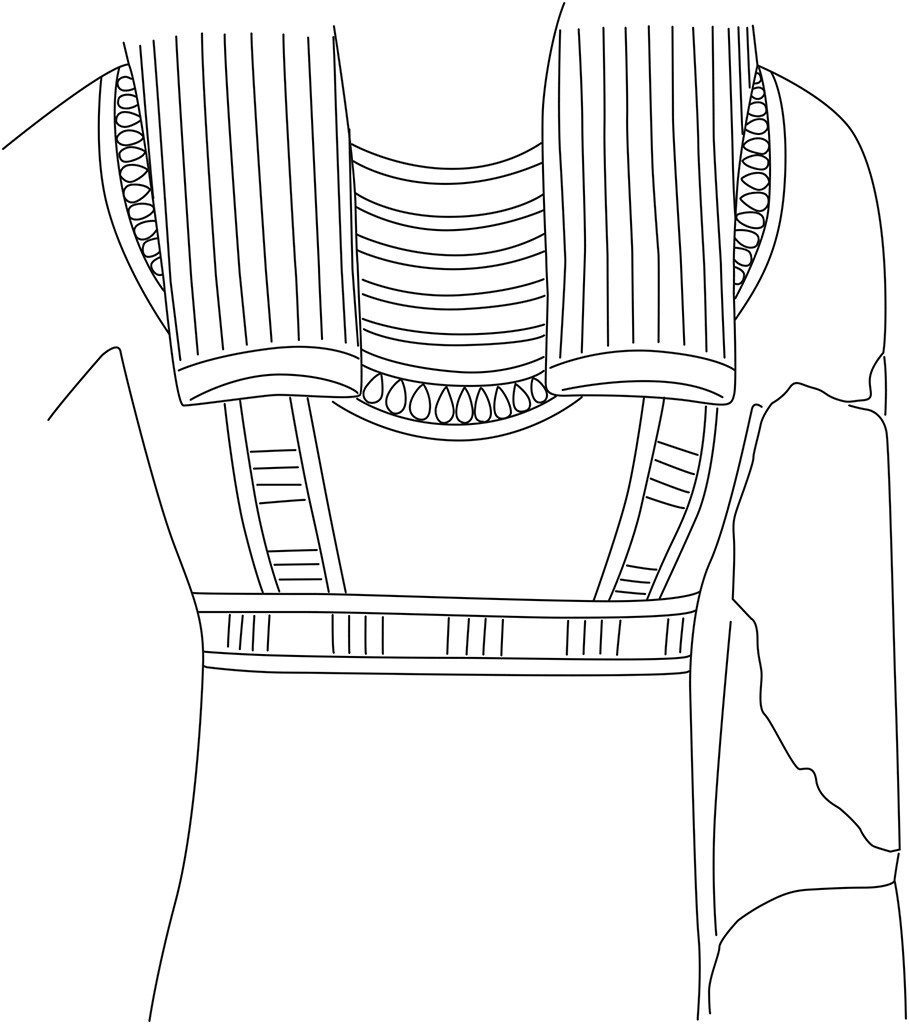
4) The headdress of the goddess consists of a tripartite wig surmounted by a modius supporting a solar disc nested between the lyre-shaped pair of horns. The type of the tripartite wig is very traditional and can hardly be used as a dating criterion (Fig. 20).30 In statues of the late Eighteenth and Nineteenth Dynasties, Mut usually wears the double crown,31 but she can occasionally be represented with a headgear probably borrowed from Hathor and Isis. During the New Kingdom, the sun-disc combined with horns becomes indeed a generalized feature for the representations of goddesses and queens. This attribute appears most often above a modius, or directly surmounts
Lyre-shaped pairs of horns on statues of New Kingdom queens and goddesses. Drawing: S. Connor.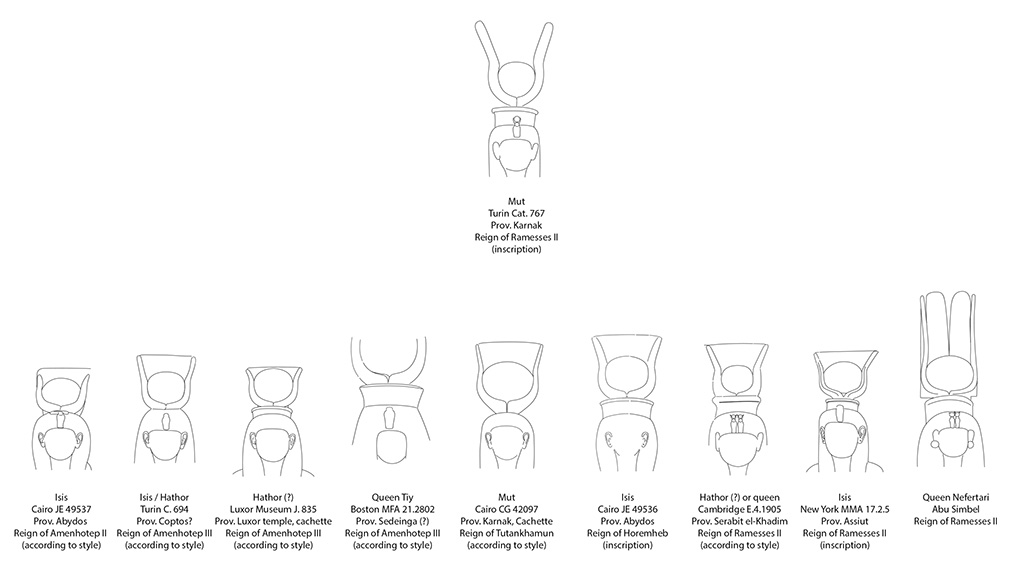
5) The royal belt is composed of horizontal folds, which could be either the result of a schematized double or triple band that usually features a frieze pattern, or may simply reproduce a pleated shawl. Such a belt is attested on statues of Amenhotep III,38 Tutankhamun,39 Sety I40 and Ramesses II.41 As for the god’s belt adorned by a double frieze decoration, it also appears under Sety I and Ramesses II, sometimes on royal statues, but particularly on divine figures in a statuary group.42
6) The horizontally pleated ceremonial kilt of the king is adorned with a finely wrought apron flanked by two pairs of ribbons and ornamented with horizontal incisions, ending with a row of pendants flanked by two uraei. It finds parallels (with variations such as a different number of uraei or the presence of a leopard head) under Amenhotep III, Akhenaten, Tutankhamun and Ramesses II.43 This kilt pattern could be the result of re-carving under Ramesses II, but might also be part of the original sculpture if it was actually made during the Eighteenth Dynasty.
Kilt of the king. Turin Cat. 767. Photo: S. Connor.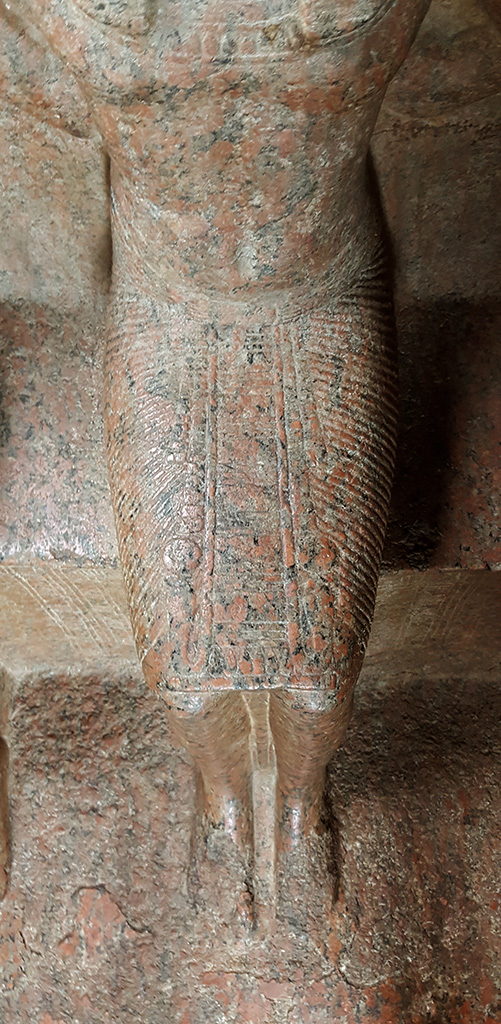
Ornament of the pleated ceremonial kilt in New Kingdom royal statues. Drawing: S. Connor.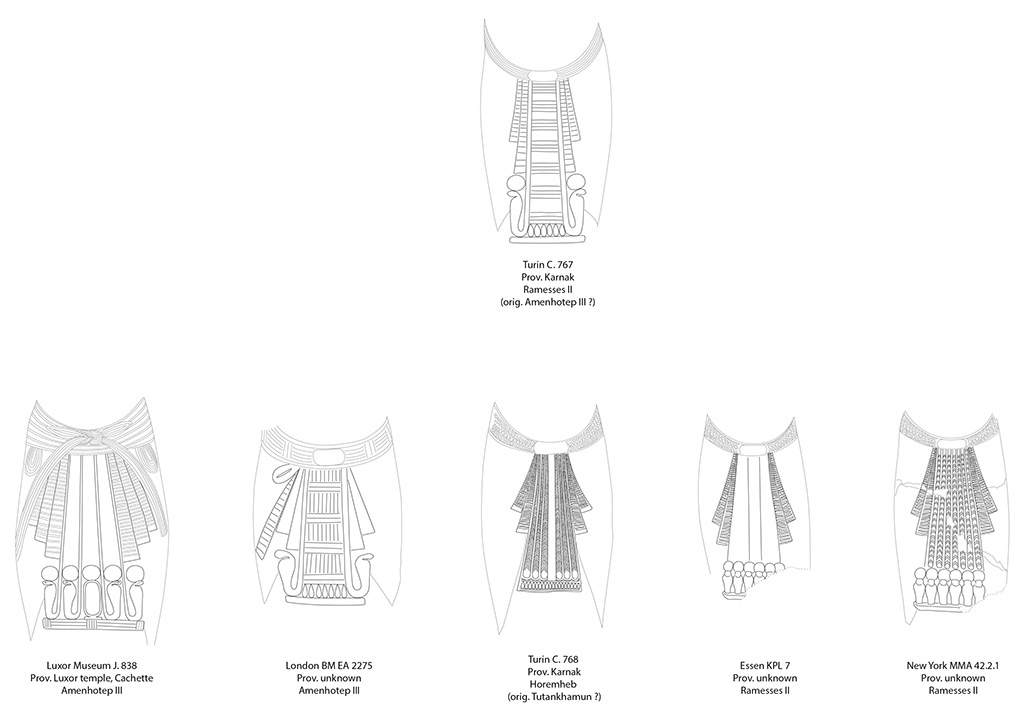
7) The tail is attached to the back of the kilt. This feature is clearly indicated in statuary, starting from the reign of Amenhotep III, by a trapezoidal or rectangular element that is still observed during the reign of Ramesses II.44
8) The collars and bracelets were not incised or carved in recess in the pre-existing surface, as is the case with most statues reused by Ramesses II.45 Therefore, unless the whole surface of an earlier statue was entirely transformed during the Ramesside period, which seems unlikely, these ornaments must have already
Post-Amarna characteristics
1) A frieze pattern decorates the front of the thrones of statues under Horemheb47 and Sety I,48 while a similar motive delimiting each of the three respective thrones, as in the case of the Turin triad, is also attested under Horemheb.49 As in the case of the royal kilt, this feature would therefore seem to be post-Amarna. Nevertheless, it is an easy-to-add detail and may well be an addition made during the hypothetical repair and reuse of the statue during the reign of Ramesses II.
Pre-Amarna characteristics
1) The general appearance of this triad is reminiscent of pre-Amarna sculpture. The slender limbs, particularly the legs, are not common in the Ramesside period; their proportions remind us rather of Thutmoside statuary.
2) Speaking against a Thutmoside dating, however, are the torsos, which are flat and thin, but not very elongated. Thutmoside torsos are generally slender, while statues of Amenhotep III often have a relatively short torso. The kilt worn by the king, with an apron adorned with uraei and solar discs, also finds no parallel before the reign of Amenhotep III, and is widely attested in Ramesside iconography. If the statue originally belonged to the Thutmoside period, it must have consequently undergone deep re-carving, leaving no trace of the original surface detectable. The knees are also very simple, with rounded kneecaps, as found under Amenhotep III and afterwards. In the Thutmoside period, they are generally more detailed and polygonal
3) Particularly noticeable is the absence of a beard. In the statuary corpus of the kings of the Nineteenth Dynasty, the nemes is generally associated with the cerimonial beard.50 Instead, the nemes and the smooth-chinned face are widely attested during the Eighteenth Dynasty. If we consider only group statues associating the king to deities, examples include the group of a king (Amenhotep II?) seated with the gods of the Abydenian triad (Cairo JE 49537),51 as well as the triad representing Tutankhamun seated between Amun and Mut (Cairo CG 42097)52 and the above-mentioned triad of Thutmose I restored during the post-Amarna period (Cairo CG 42052). Nevertheless, this is only a statistical argument, which has to be considered cautiously, since statues of the Eighteenth Dynasty can also show the beard associated with the nemes.53
4) The uninscribed rear part of the back slab is exceptional under Ramesses II. The inscriptions that usually adorn the back of triads are placed here at the front of the dorsal panel. Furthermore, the cartouche which is usually displayed vertically between the figures is carved horizontally here, due to lack of space. The explanation for the lack of an inscription on the back may be that the statue was carved in the Eighteenth Dynasty, when such an absence was common. The reason, then, for the – atypical for the Ramesside period – carving of the inscription on the front of the panel would be that this earlier statue was recarved when it was standing against a wall.
5) A further argument in favour of an earlier statue reused by Ramesses II is typological: while the mutually embracing attitude is well attested during the Eighteenth Dynasty,54 only one example is known so far for the Nineteenth: a triad on display in the open-air museum of Mit Rahina, which shows Ramesses II seated between two figures of Hathor (Fig. 23). Approximatively of the same dimensions as the granite triad in Turin, the limestone triad in Mit Rahina also displays slender proportions, as well as an association of the nemes with the henu-crown – but also with the royal beard. A close study of that sculptural group would be necessary to ascertain its date.
In the corpus of statuary preserved, during the Nineteenth Dynasty, the goddesses sometimes pass an arm behind the back or on the shoulder of their male counterpart, but the gesture is not reciprocal (Figs. 25, 26).
Mit Rahina, open-air museum. Triad showing Ramesses II between two figures of the goddess Hathor. Limestone. H. ca. 160 cm. Photos: S. Connor.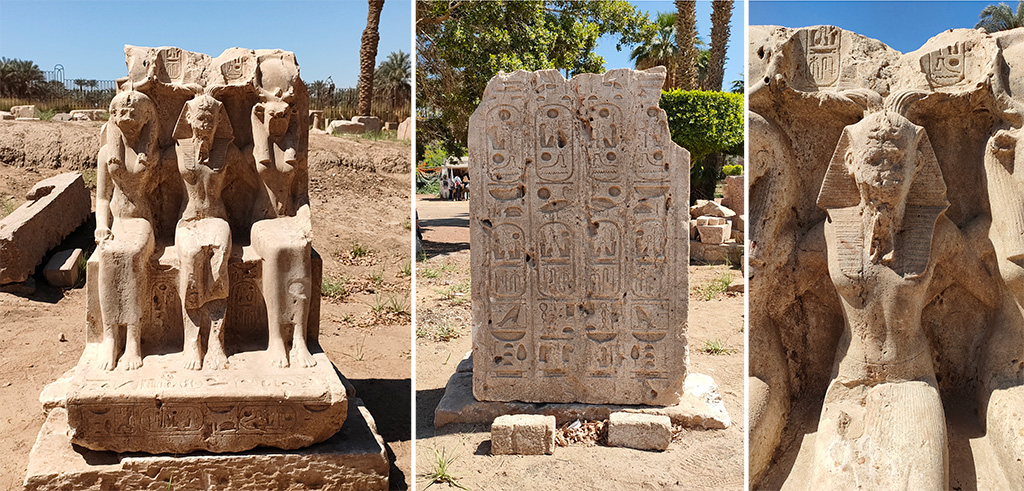
Turin Cat. 767. Photo by Pino and Nicola Dell’Aquila / Museo Egizio.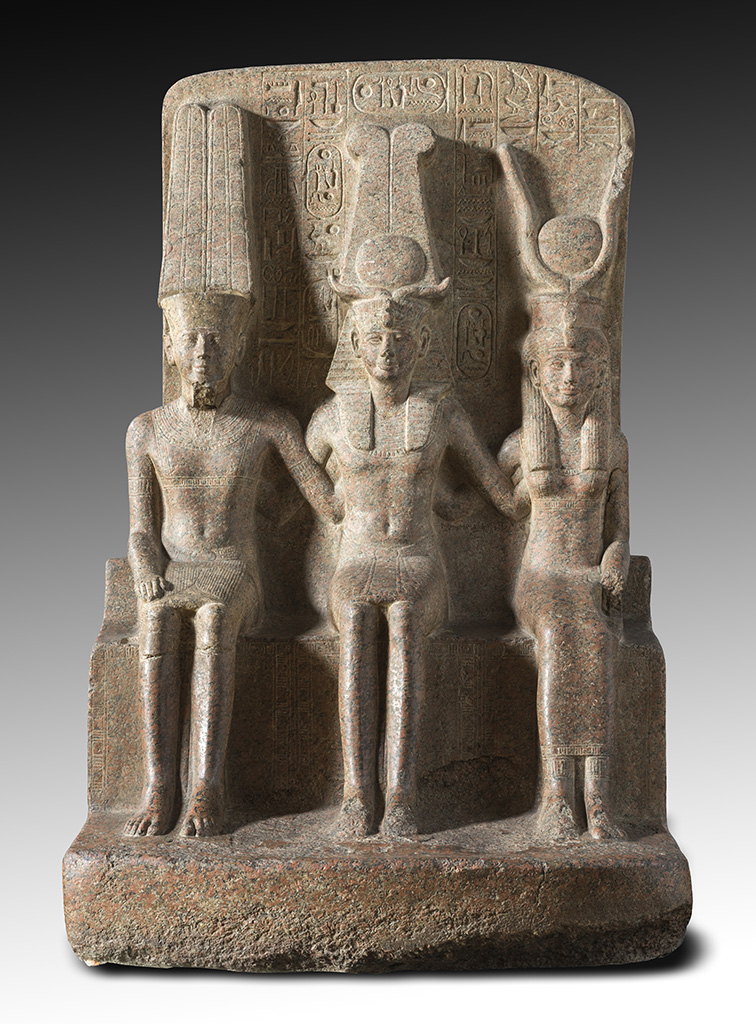
Group statue showing Ramesses II, Horus, Osiris, Isis and Sety I. Abydos, temple of Ramesses II. Granodiorite. H. 194 cm. Photo: S. Connor, courtesy of Abydos Inspectorate.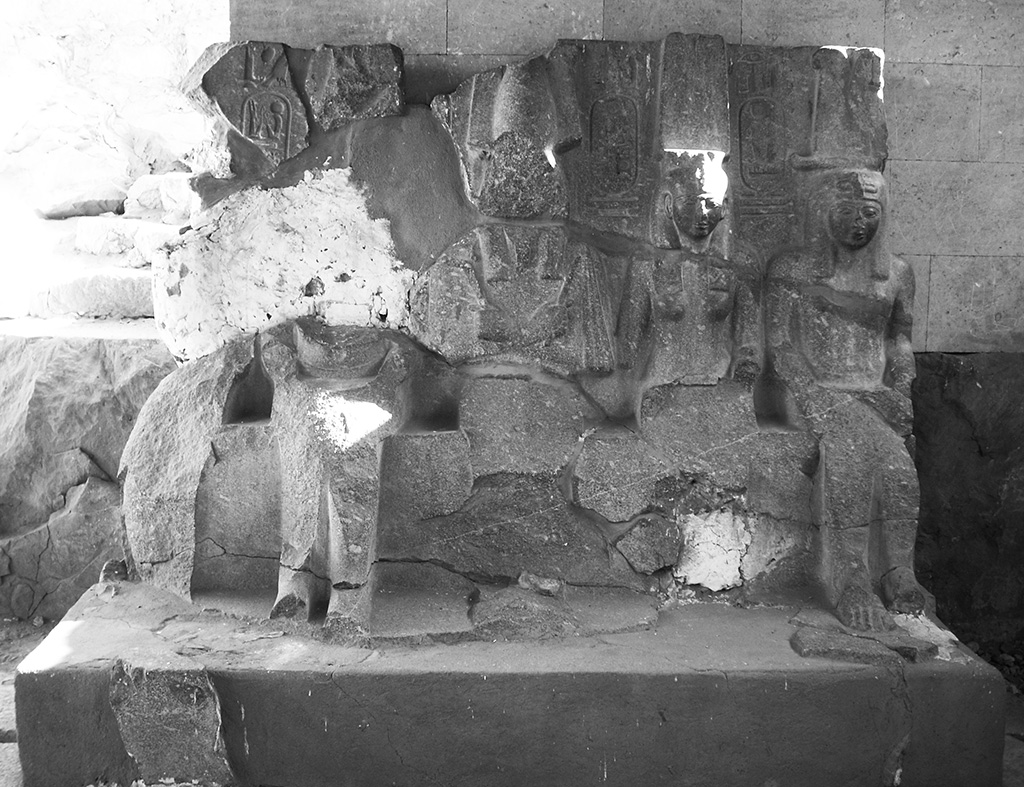
Cairo JE 56366. Dyad showing Ramesses II and the goddess Anta. Granodiorite. H. 190 cm. Photo Egyptian Museum, Cairo / S. Connor.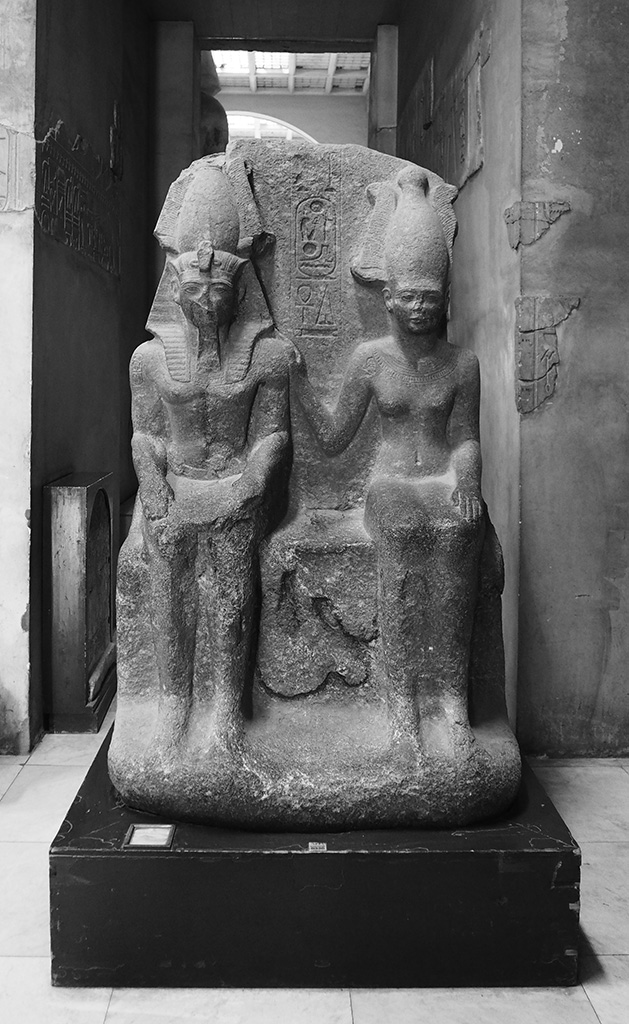
Discussion concerning the dating of the statue
The general appearance of the piece, the statuary type with the mutually embracing posture of the figures, as well as a number of iconographic (such as the shape of the crown) and stylistic details (slender proportions) are reminiscent of the statuary of the Eighteenth Dynasty. By contrast, the restorations
1) The statue was sculpted during the Eighteenth Dynasty, at the latest shortly before or during the reign of Amenhotep III, probably for a Theban temple, either Karnak or Kom el-Hettan, where several other group statues were discovered.
2) The group was defaced during the reign of Akhenaten. The attacks were aimed at the face, knees and right hand of the god, as well as the left arm of the goddess (Fig. 23), but left intact the goddess’s face and the whole figure of the king, as well as, apparently, the rest of the statue. The beard of the god was carefully erased.
3) The statue was then left in that condition until the reign of Ramesses II, when it was restored. The restoration included the integration of carved patches for the damaged areas, similarly to the statues repaired during the reign of Tutankhamun mentioned above, but this time it also included a re-appropriation of the statue by re-carving its inscriptions and updating the style of the figures, following a practice widely attested under Ramesses II. The alternative interpretation, i.e., that we are dealing with an original statue carved during the reign of Ramesses II, is more difficult to accept. First, if this statue had been made for Ramesses II, it would have been particularly archaistic, showing a concentration of typological, iconographic and also stylistic nods to Eighteenth Dynasty sculpture. Secondly, if the restorations had followed accidental breaks, perhaps occurred during the manufacturing or transportation of the statue, it would be difficult to explain why this damage would have been limited to the face and hand of the god, as well as the arm of the goddess, i.e. precisely those parts that allowed the figures to act and be “alive”.
5. Ancient restorations in Egyptian sculpture
Ancient restorations are frequently attested in the repertoire of Egyptian statuary that has been handed down to us.55 Examples include colossal statues, whose size rendered them more susceptible to breakage due to their excessive weight, natural fractures within a large block of the stone, and the risks involved in carving the statue as well as in transporting it. Repairs by mortises and stone dowels are clearly visible on several statues. Among many instances, we may cite the rear part and right arm of the western seated colossus in front of the pylon of Luxor temple,56 the throne of a Twelfth Dynasty colossus
Standard bearer statue of Ramesses II in Buto (detail). Granite. H. 280 cm. Photos: H. Sourouzian, courtesy of Buto Inspectorate.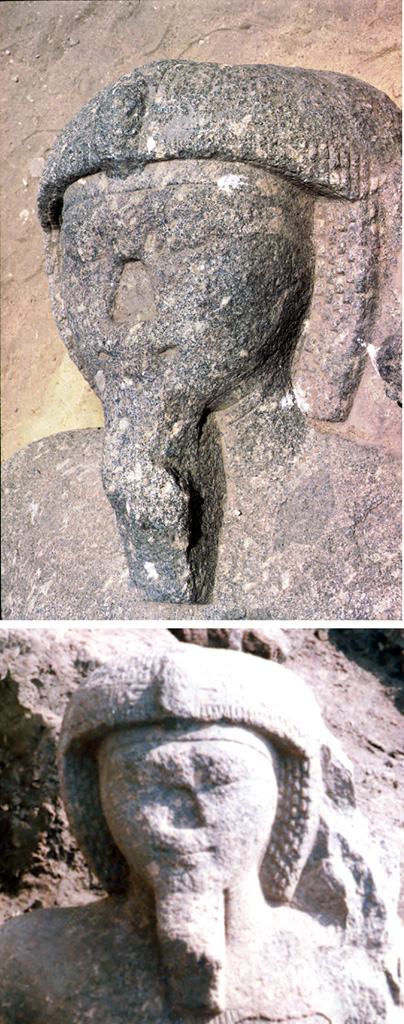
In some cases, repairs can be made to accidentally broken pieces, while in others they may have aimed at re-activating damaged sculptures. The most illustrative examples of the latter instance are the statues (and group statues) depicting the god Amun hacked during the Amarna period and restored during the subsequent reigns:
1) Cairo JE 37394 – CG 42052:64 seated triad depicting the god Amun-Ra between the figures of Thutmose I and Ahmose (Fig. 28). From the Cachette of Karnak. Egyptian alabaster. H. 69; W. 38 cm. The figure of Amun has been entirely reconstructed: the legs and feet are made of a separate piece, inserted into the main body of the statue (the veins of the stone are clearly different). Plaster is visible behind the legs and under the feet. The upper part (up to the waist) of the whole triad is another separate piece, inserted in the lower part of the original statue. Although the inscriptions still describe the rulers as Thutmose I and Ahmose, the facial features clearly show the style of the post-Amarna period, most likely the reign of Tutankhamun.
Cairo CG 42052. Photo Egyptian Museum, Cairo / S. Connor.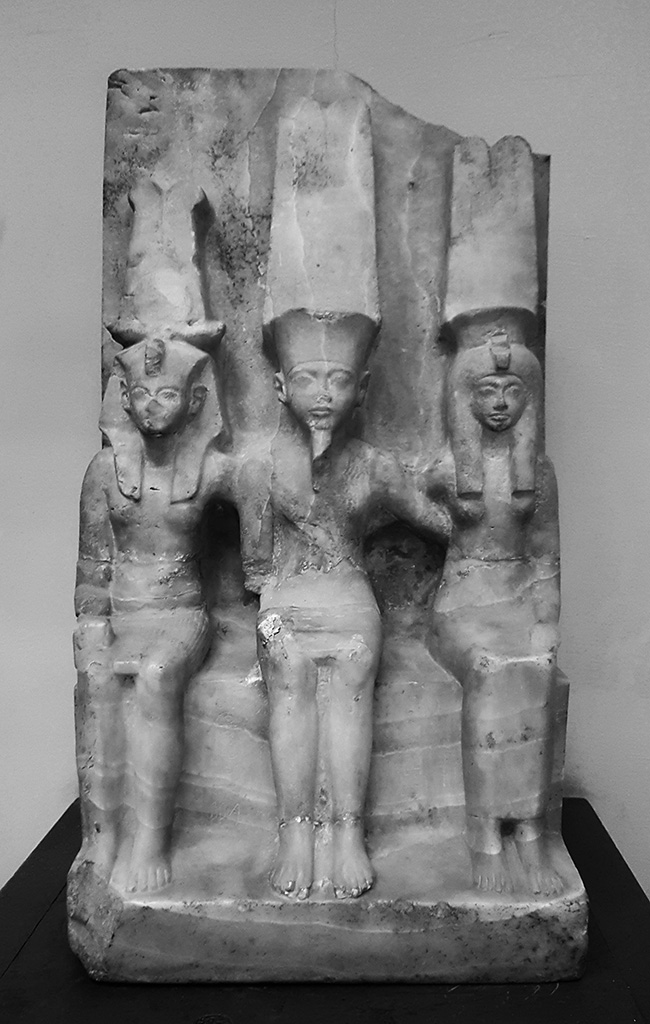
2) Cairo JE 36909 – CG 42066:65 seated dyad depicting Thutmose III with Amun-Ra. From the Cachette of Karnak. Greywacke. H. 68; W. 31; D. 33 cm. The god’s figure is much smaller than the king’s and shows a different stylistic treatment for the body. The figure of Thutmose III is, moreover, in a very good state of preservation, while the head of Amun is completely missing. Two mortises cut into the dorsal panel clearly once allowed a new head for the god to be fixed in place, most probably during the post-Amarna period.
3) Cairo JE 36904 – CG 42065:66 seated dyad depicting a king (Thutmose III or Amenhotep II?) with Amun-Ra (Fig. 29). Granite. H. 125 cm. The face of the king displays the characteristic features of the mid-Eighteenth Dynasty and does not show any trace of ancient modification. However, the god’s face is made of a separate piece of granite, inserted inside the head. This fragment is of a different, more reddish variety of granite, and its stylistic features correspond to those typical of the late Eighteenth
Cairo CG 42065. Photos Egyptian Museum, Cairo / S. Connor.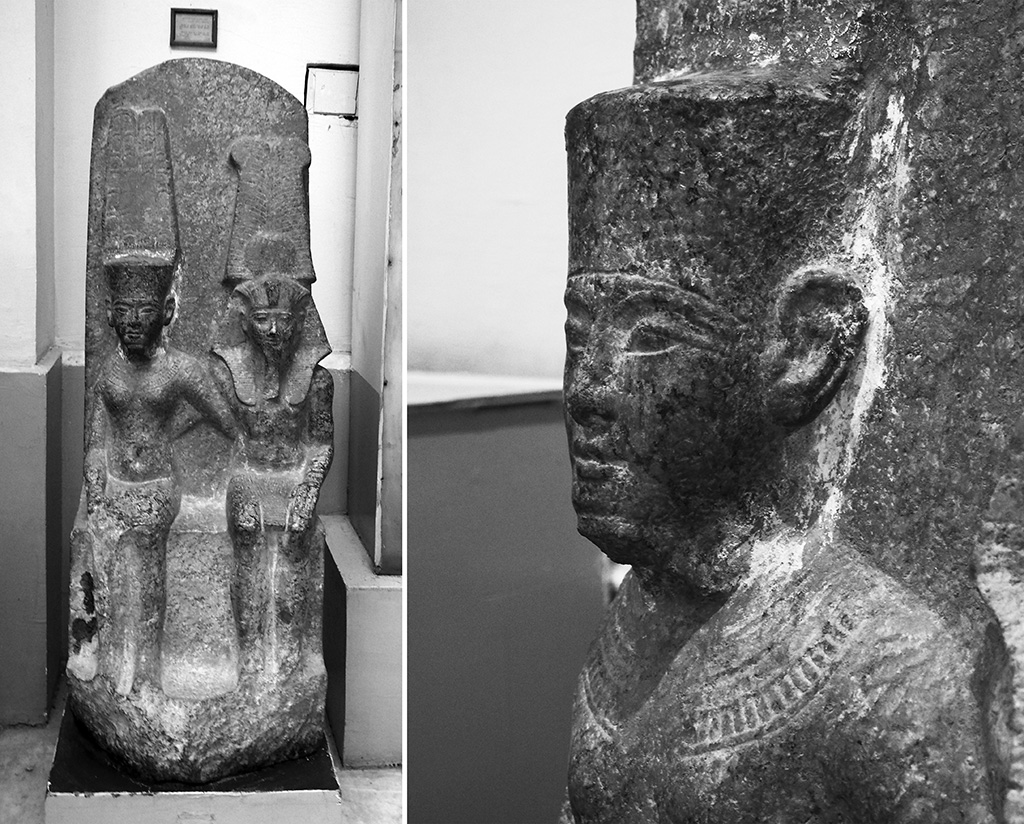
4) Paris E 10377 (AF 77):67 torso of a seated statue of the god Amun. Granodiorite. H. 67.8; W. 30.4; D. 21.3 cm. The edges of the rear and lower parts of the piece clearly indicate that it is not a broken fragment of a statue, but a complete piece for restoration, with polished geometric plans that allowed it to be inserted inside a statue. The facial and body features show the style of the late Eighteenth Dynasty.
5) Brussels E. 5698:68 face of the god Amun (Fig. 30). Granodiorite. H. 17.2; W. 15; D. 14.6 cm. The rear part of the piece shows plain and geometrically cut edges. It is clear that it is not a natural break. Like the previous piece, this face is not a fragment, but a complete element of restoration that was once inserted into the main block of a statue damaged during the Amarna period.
Brussels E. 5698. Photos: S. Connor, courtesy of the Musées royaux d’Art et d’Histoire.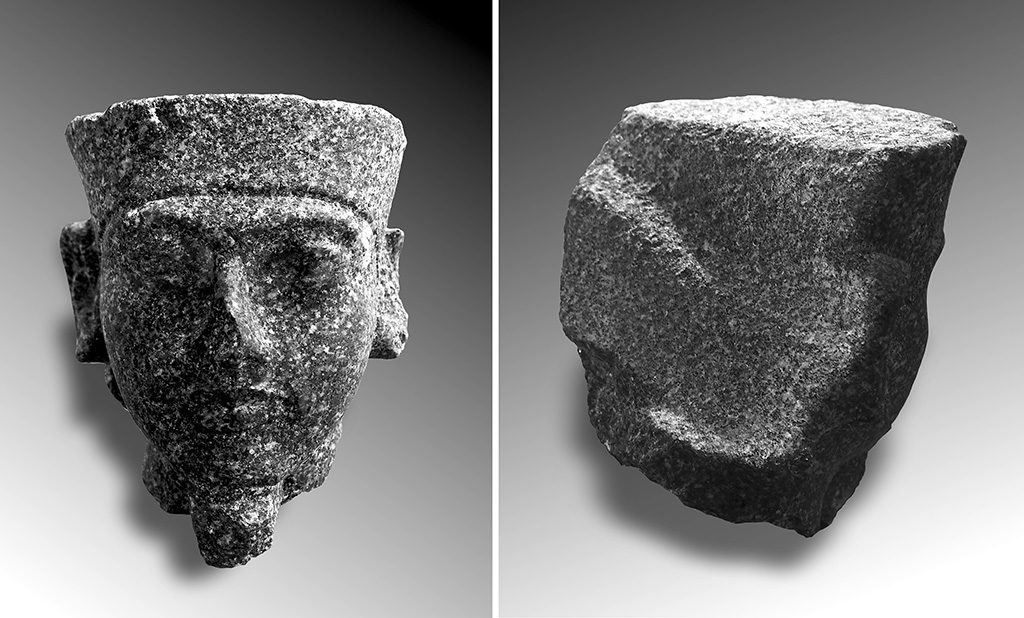
6) Copenhagen ÆIN 35:69 face of the god Amun (Fig. 31). Granodiorite. H. 35 cm. As observed by Marianne Eaton-Krauss, the rear part of this head is flat, and she mentions a tenon on the left side, which allowed the face to be attached to the back of the statue, either a slab or a pillar. Like the two previous pieces, it was most probably a repair element sculpted during the post-Amarna period to re-activate a damaged pre-Amarna statue of Amun.
Copenhagen ÆIN 35. Photos: left and centre, S. Connor; right, Ole Haupt Ny Carlsberg Glyptotek.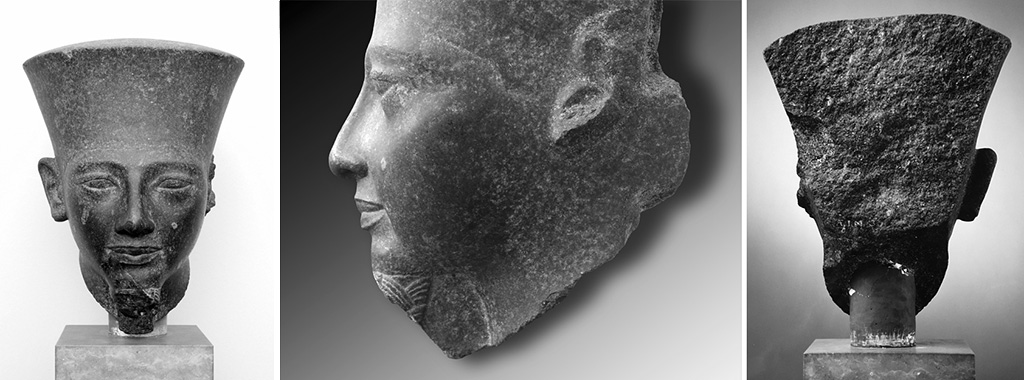
These six cases of restoration date back to the years following the return to orthodoxy, after the Amarna period, and the reinstatement of Amun as the dynastic god. The facial features of the restored parts all show the stylistic characteristics of the representations of Tutankhamun, Ay or Horemheb.70 It is likely that the difference in style between the original figure(s) still visible on these dyads and the restored figure of Amun reflects an intentionality. The aim of these repairs was not to hide the damage, but rather to make the restoration visible, materializing the extensive campaign of restoration of the post-Amarna rulers.71 None of these restored statues, however, shows any sign of re-appropriation or “usurpation”72 of the ancient statues; what we are looking at is simply a restoration of the broken fragments. The added elements show the stylistic features of the time to which they belonged, i.e., the post-Amarna period, but the identity of the originally represented king was preserved, as was the style of the non-damaged parts of the statues. Returning to the Turin triad, Cat. 767, we are most probably confronted with a similar situation: the restoration of a pre-Amarna statue, particularly as regards the restoration of Amun’s face with a patch. The sculpture’s style, iconography and proportions weigh in favour of such an interpretation, being so reminiscent of Eighteenth Dynasty sculpture.
The case of the Turin triad allows us to make a consideration on the evolution of the practice of restoring. The pre-Amarna statues damaged under Akhenaten and restored at the end of the Eighteenth Dynasty were not re-inscribed, even though the patches showed the style of Tutankhamun’s time. There was
We are particularly grateful for the comments of several colleagues, including our anonymous peer-reviewers.73 This statue requires careful methodological analysis and special care is required when interpreting traces of ancient restorations. The type of restoration that the piece underwent, with the face of the god Amun consisting of a separate piece plugged into the main body of the statue, is characteristic of post-Amarna manipulations carried out on Amun’s images damaged during the reign of Akhenaten. The above in-depth stylistic and iconographic analysis shows how complex a process this can be.
Through the various stages of its life, which have left traces on its surface, this example illustrates the importance that the ancient Egyptians granted to statues. These were not only objects of great material value, produced in prestigious materials after hundreds of hours of work by specialised sculptors invested with the task by the state. They were also magical works, endowed with power, which could be activated by means of offerings, rituals, and specific changes, restorations and transformations. By means of such alterations, an ancient object could be given a new life. The statue, even when mutilated, remained imbued with an aura that served to perpetuate the topos of the royal restorer, guarantor of order and main actor of the cult.
Bibliography
Aldred, Cyril, “A Statue of King Neferkare Ramesses IX”, JEA 41 (1955), pp. 3–8, pl. 1.
Barbotin, Christophe, Les statues égyptiennes du Nouvel Empire : statues royales et divines, Paris 2007.
Barbotin, Christophe, “Un cas antique de restauration au musée du Louvre”, in : Dominique Valbelle and Jean-Michel Yoyotte (eds.), Statues égyptiennes et kouchites démembrées et reconstituées: Hommage à Charles Bonnet, Paris 2011, pp. 65–70.
Bryan, Betsy M., “Striding Glazed Steatite Figures of Amenhotep III: An Example of the Purposes of Minor Arts”, in: Elizabeth Goring, Nicholas Reeves, and John Ruffle (eds.), Chief of Seers: Egyptian Studies in Memory of Cyril Aldred, London-New York-Edinburgh 1997, pp. 60–82.
Bryan, Betsy M., “The Statue Program for the Mortuary Temple of Amenhotep III”, in: S. Quirke (ed.), The Temple in Ancient Egypt: New Discoveries and Recent Research, London 1997, pp. 57–81.
Carlotti, Jean-François and Laetitia Gallet, “Le temple d’Amon-qui-écoute-les-prières à Karnak. Œuvre de Ramsès II ou d’un prédécesseur?” in: J.-C. Goyon and C. Cardin (eds.), Proceedings of the Ninth International Congress of Egyptologists. Grenoble 6-12 septembre 2004. Leuven-Paris-Dudley (MA) 2007, II, pp. 271–82.
Charron, Alain and Christophe Barbotin (eds.), Khâemouaset, le prince archéologue : savoir et pouvoir à l’époque de Ramsès II (catalogue of the exhibition, Arles, Musée départemental Arles antique, 8 October 2016 – 22 January 2017), Arles-Gand 2016.
Cherpion, Nadine and Jean-Pierre Corteggiani, La tombe d’Inherkhâouy (TT 359) à Deir el-Medina, 2 vols. (Mémoires publiés par les membres de l’Institut français d’archéologie orientale 128), Cairo 2010.
Cincotti, Silvana, “
“Collezione Drovetti : a. 1822. Catalogue de la collect. d’antiq. de mons. le chev. Drovetti”, in Ministero della Pubblica Istruzione (ed.) Documenti inediti per servire alla storia dei Musei d’Italia, III, Firenze-Roma 1880.
Connor, Simon, Le statue del Museo Egizio, Torino-Modena 2016.
Connor, Simon, La statua di Ramesse II, Torino-Modena 2017.
Connor, Simon, “Mutiler, tuer, désactiver les images en Égypte pharaonique”, Perspective : actualité en histoire de l’art 2018 (2), pp. 147–66, http://journals.openedition.org/perspective/11431, https://doi.org/10.4000/perspective.11431.
Connor, Simon, “Killing or ‘De-Activating’ Egyptian Statues: Who Mutilated Them, When, and Why?” in: Aurélia Masson-Berghoff (ed.), Statues in Context: Production, Meaning and (Re)uses, Leuven, 2019, pp. 282–302.
Daressy, Georges, Statues de divinités. Catalogue général des antiquités égyptiennes du Musée du Caire (n° 38001-39384), Cairo 1905–1906.
De Forbin, Comte de, Voyage dans le Levant, en 1817 et 1818, Paris 1819.
Eaton-Krauss, Marianne, “JE 49536: Horemheb and the Abydene Triad”, SAK 11 (1984), pp. 501–08.
Eaton-Krauss, Marianne, “Sculpture in Early Dynastic Egypt”, in: Diana Craig Patch (ed.), Dawn of Egyptian Art (Catalogue of the exhibition, New York, Metropolitan Museum of Art, 10 April – 5 August 2012), New York-New Haven-London 2012, pp. 180–93.
Eaton-Krauss, Marianne, “Usurpation”, in Richard Jasnow and Kathlyn M. Cooney (eds.), Joyful in Thebes: Egyptological Studies in Honor of Betsy M. Bryan, Atlanta 2015, pp. 97–104.
Eaton-Krauss, Marianne, “Usurpationen”, in: L. Petersen (ed.), Ramses: göttlicher Herrscher am Nil, Petersberg 2016, 73–75.
Eaton-Krauss, Marianne, The Unknown Tutankhamun, London 2016.
Eaton-Krauss, Marianne, “L’après Amarna. Restaurer le culte d’Amon”, in: Simon Connor and Dimitri Laboury (eds.), Toutankhamon: à la découverte du pharaon oublié (catalogue of the exhibition, Liège, espace Europa Expo à la gare TGV des Guillemins, 14 December 2019 – 31 May 2020), Liège 2019, pp. 260–67.
Eaton-Krauss, Marianne, Post-Amarna Period Statues of Amun and His Consorts Mut and Amunet (Harvard Egyptological Studies 9), Leiden-Boston 2020.
El-Saghir, Mohammed, The Discovery of the Statuary Cachette of the Luxor Temple (SDAIK 26), Mainz 1991.
Epigraphic Survey, Reliefs and Inscriptions at Luxor Temple, Volume 2: The Facade, Portals, Upper Register Scenes, Columns, Marginalia, and Statuary in the Colonnade Hall: With Translations of Texts, Commentary, and Glossary (Oriental Institute Publications 116), Chicago 1998.
Gallet, Laetitia, “Karnak: The Temple of Amun-Ra-Who-Hears-Prayers”, in: Willeke Wendrich (ed.), UCLA Encyclopedia of Egyptology, Los Angeles 2013. https://escholarship.org/uc/item/3h92j4bj
Gräzer Ohara, Aude, Treasures from the Lost City of Memphis. Objects from the Museum Sculpture Garden, Boston 2020.
Hardwick, Tom, “The Iconography of the Blue Crown in the New Kingdom”, JEA 89 (2003), pp. 117–41.
James, T.G.H., “A Ramesside Divine Sculpture at Kingston Lacy”, in: Christopher Eyre, Anthony Leahy, and Lisa Montagno Leahy (eds.), The Unbroken Reed: Studies in the Culture and Heritage of Ancient Egypt in Honour of A. F. Shore, London 1994, pp. 139–48.
Jørgensen, Mogens, Catalogue Egypt II (1550-1080 BC) Ny Carlsberg Glyptotek, Copenhagen 1998.
Jung, Marie-Paule, “Restauration et entretien de la statuaire dans les temples égyptiens : un aperçu”, Technè [online] 40|2014, consulted on 11th March 2021, http://journals.openedition.org/techne/3402; https://doi.org/10.4000/techne.3402
Kemp, Barry J., “The Colossi from the Early Shrine at Coptos in Egypt”, Cambridge Archaeological Journal 10/2 (2000), pp. 211–42.
Kemp, Barry J., Ancient Egypt: Anatomy of a Civilization, 3rd revised and updated ed., London – New York 2018.
Kozloff, Arielle P. and Betsy M. Bryan (eds.), Egypt’s Dazzling Sun: Amenhotep III and His World (catalogue of the exhibition, Cleveland Museum of Art, 1 July – 27 September 1992), Cleveland (OH) 1992.
Laboury, Dimitri, La statuaire de Thoutmosis III : essai d’interprétation d’un portrait royal dans son contexte historique (AegLeod 5), Liege 1998.
Laboury, Dimitri, “Colosses et perspective de la prise en considération de la parallaxe dans la statuaire pharaonique de grandes dimensions au Nouvel Empire”, RdE 59 (2008), pp. 181–230.
Legrain, Georges, Statues et statuettes de rois et de particuliers I (Catalogue général des antiquités égyptiennes du Musée du Caire), Cairo 1906.
Lindblad, Ingegerd, Royal Sculpture of the Early Eighteenth Dynasty in Egypt (Medelhavsmuseet Memoir 5), Stockholm 1984.
Manniche, Lise, The Akhenaten Colossi of Karnak, Cairo-New York 2010.
Montet, Pierre, “Les fouilles de Tanis en 1933 et 1934”, Kêmi 5 (1935-1937), pp. 1–18.
Müller, Maya, “Über die Büste 23725 in Berlin”, Jahrbuch der Berliner Museen 31 (1989), pp. 7–24.
Oppenheim, Adela, Dorothea Arnold, Dieter Arnold, and Kei Yamamoto (eds.), Ancient Egypt Transformed: The Middle Kingdom, New Haven-London 2015.
Otto, Eberhard, “Duawer”, in: Wolfgang Helck and Eberhard Otto (eds.), Lexikon der Ägyptologie I, Wiesbaden 1975, col. 1151.
Rifaud, Jean-Jacques, Tableau de l’Egypte, de la Nubie et des lieux circonvoisins ; ou itinéraire à l’usage des voyageurs qui visitent ces contrées, Paris 1830.
Rogge, Eva, Kunsthistorisches Museum Wien, Ägyptisch-orientalische Sammlung, Lieferung 6: Statuen des Neuen Reiches und der Dritten Zwischenzeit (Corpus antiquitatum Aegyptiacarum), Mainz/Rhein 1990.
Seidel, Matthias, Die königlichen Statuengruppen, I. Die Denkmäler vom alten Reich bis zum Ende der 18. Dynastie (HÄB 42), Hildesheim 1996.
Simpson, William Kelly, “Egyptian Sculpture and Two-Dimensional Representation as Propaganda”, JEA 68 (1982), pp. 266–71.
Sourouzian, Hourig, Les monuments du roi Merenptah (SDAIK 22), Mainz 1989.
Sourouzian, Hourig, “A Bust of Amenophis II at the Kimbell Art Museum”, JARCE 28 (1991), pp. 55–74.
Sourouzian, Hourig, “Amun und Mut: eine Doppelstatue aus der Zeit des Haremheb (1320-1306 v. Chr.). Die Restaurierung einer monumentalen Statuengruppe im Ägyptischen Museum Kairo”, Antike Welt 30/6 (1999), pp. 595–97.
Sourouzian, Hourig, “Raccords de statues d’Aménophis III (suite)”, BIFAO 107 (2007), pp. 213–42.
Sourouzian, Hourig, “Seti I, Not Osorkon II: A New Join to the Statue from Tanis, CG 1040, in the Cairo Museum”, in: Ola El-Aguizy and Mohamed Sherif Ali (eds.), Echoes of Eternity. Studies Presented to Gaballa Aly Gaballa (Philippika 35), Wiesbaden 2010, pp. 97–105.
Sourouzian, Hourig, Catalogue de la statuaire royale de la XIXe dynastie (BdE 177), Cairo 2019.
Sourouzian, Hourig, Recherches sur la statuaire royale de la XIXe dynastie (BdE 173), Cairo 2020.
Szafrański, Zbigniew E., “Buried Statues of Mentuhotep II Nebhepetre and Amenophis I at Deir el-Bahari”, MDAIK 41 (1985), pp. 257–63.
Te Velde, Herman, “Zeremonialbart”, in: Wolfgang Helck and Eberhard Otto (eds.), Lexikon der Ägyptologie, VI, Wiesbaden 1986, coll. 1396–1397.
Traunecker, Claude, “Une pratique de magie populaire dans les temples de Karnak”, in Alessandro Roccati and Alberto Siliotti (eds.), La magia in Egitto ai tempi dei faraoni: atti, convegno internazionale di studi, Milano, 29-31 ottobre 1985, Verona 1987, pp. 221–42.
Van Rinsveld, Bernard, Dieux et déesses de l’ancienne Égypte (Guides du Département Égyptien 9), Brussels 1994.
Vandersleyen, Claude, “La statue de Ramsès II du Musée d’Art et d’Histoire de Genève réexaminée”, Genava 31 (1983), pp. 17–22 (= “La statue de Ramsès II du Musée d’Art et d’Histoire de Genève réexaminée”, in Claude Vandersleyen, Écrits sur l’art égyptien : textes choisis, edited by Nadine Cherpion and Anne-Laure Oosthoek [Connaissance de l’Égypte Ancienne 13], Brussels 2012, pp. 273).
Vandersleyen, Claude, “Ramsès II admirait Sésostris Ier”, in: Elizabeth Goring, Nicholas Reeves and John Ruffle (eds.), Chief of Seers: Egyptian Studies in Memory of Cyril Aldred, London-New York 1997, pp. 285–90.
Volokhine, Youri, “Barbe et barbus en Égypte ancienne”, in : Youri Volokhine, Bruce Fudge, and Thomas Herzog (eds.), Barbe et barbus : symbolique, rites et pratiques du port de la barbe dans le Proche-Orient ancien et moderne (Études genevoises sur l’Antiquité 5), Berne 2019, pp. 59–87.
van Walsem, René, “Creases on the Throat as an Art Historical Particularity in Deir el Medina”, in: Ben J.J. Haring, Olaf E. Kaper, and René van Walsem (eds.), The Workman’s Progress: Studies in the Village of Deir el-Medina and Other Documents from Western Thebes in Honour of Rob Demarée (EgUit 28), Leuven 2014, pp. 261–89.
Notes
- PM II2, 215; Rifaud, <i>Tableau de l’Égypte</i>, 1830; see Cincotti, <i>Cahiers de Karnak</i> 14 (2013).↑
- As suggested by M. Eaton-Krauss in the case of the Tutankhamun triad (Cairo CG 42097), “it seems likely that [the king] assumes here the role of the lunar god Khonsu, the divine couple’s son.” (Eaton-Krauss, in Peterson and Kehrer [eds.], <i>Ramses: göttlicher Herrscher am Nil</i>, 2016, p. 58) As she mentions, M. Seidel also suggested that the embracing posture associating the king and the gods could be a way to visually manifest the reciprocity between worship and the state (Seidel, <i>Die königlichen Statuengruppen, I</i>, 1996, p. 221).↑
- Personal communication to S. Cincotti, September 2017.↑
- The restorer also found stains of bitumen (?), dripped wall paint, and cement, all relics of different treatments endured by the statue. ↑
- Jean-Jacques Rifaud was born in Marseille on November 28, 1786. Nothing is known of his childhood. We only know the names of his mother, Anne Seneq, and his father, Joseph Rifaud, a gilder. After an artistic apprenticeship under the direction of the French sculptor Barthélémy-François Chardigny, Jean-Jacques began a long journey which led him to take residence in Paris in 1805. Thanks to his employment at the Louvre construction site, he began to see a promising future, but military duty put an end to his plans: in 1807 he left for Spain. There he was captured by Catalan troops in 1808. After a series of adventurous trips, he arrived in Egypt in January 1814 and was welcomed there by the French consul Bernardino Drovetti. Thanks to Silvana Cincotti’s study of the manuscripts of the Rifaud Fonds, we know that for seven years (1817–1823) Rifaud mainly conducted his excavations in the sacred enclosure of Karnak, although he also worked in Medamud. Coming from a poor social background, his schooling was probably limited; hence the peculiar orthography and grammar of his French writing.↑
- « Catalogue », in Ministero della Cultura (ed.), <i>Documenti inediti III</i>, 1880, p. XIII.↑
- Bibliothèque de Genève, Ms. suppl. 112, f. 189.↑
- Bibliothèque de Genève, Ms. suppl. 112, f. 191.↑
- Bibliothèque de Genève, Ms. suppl. 113, f. 61 v. We thank the Geneva Library for the permission to reproduce the plate.↑
- It is likely that the finding of this statue took place in the presence of an important person, the noble Louis Nicolas Philippe Auguste, Comte de Forbin, Directeur Général des Musées de France, who was in Egypt during those years and visited Rifaud’s excavations in Karnak. The Count writes of Rifaud in his memoirs: « Nous lui vîmes déterrer, le jour même de notre arrivée, un bas-relief de granit rose, parfaitement conservé, de neuf pieds de haut, représentant les trois divinités Osiris, Isi et Horus : cet homme avait la main heureuse. » (De Forbin, <i>Voyage dans le Levant</i>, 1819, p. 267). Among the discoveries that Rifaud mentions in his memoirs, the Turin triad is the only one that corresponds to the object described by de Forbin. There is another triad found by Rifaud in Luxor which is held in the Louvre (A 12), but its dimensions do not correspond to the description provided by the French count. The day of de Forbin’s arrival in Luxor, which would thus seem to coincide with the date of the triad’s discovery, is 29 January 1818.↑
- Regarding the block statue «<i> de position acroupie</i> », it is likely to be the statue of Bakenkhonsou (GL.WAF 38), now in Munich, Staatliches Museum für Ägyptische Kunst.↑
- Rifaud,<i> Tableau de l’Egypte</i>, Paris 1830; Cincotti,<i> Cahiers de Karnak</i> 14 (2013).↑
- Concerning the “East temple” or “contra-temple” of Karnak, see Carlotti and Gallet, in Goyon and Cardin (eds.), <i>Proceedings</i>, 2007; Gallet, in Wendrich (ed.), <i>UCLA</i> <i>Encyclopedia of Egyptology</i>, 2013.↑
- See Traunecker, in Roccati and Siliotti (eds.), <i>La magia in Egitto</i>, 1987. Several large cup-marks or oval depressions were also made on various spots of the front of two of the Pre- or Early Dynastic colossi from Coptos probably representing the god Min (Oxford AN1894.105.d–e), as well as on the side of an early statue from Hierakonpolis (Oxford AN1896-1908); see Kemp, <i>Cambridge Archaeological Journal</i> 10/2 (2000), pp. 226-27; Eaton-Krauss, in Patch (ed.), <i>Dawn of Egyptian Art</i>, 2011, pp. 181–85; Kemp, <i>Anatomy of a Civilization</i>, 2018, pp. 133–35. ↑
- During the New Kingdom, sculptors took into account the perspective induced by the size of a statue, using it as a criterion for the shaping of the features of the individual represented. See Laboury, <i>RdE</i> 59 (2008).↑
- E.g., the statue of Ramesses II “in majesty” in Turin, Cat. 1380, has a particularly forward-bent face, with the gaze pointing downwards, apparently with the aim of creating eye contact with the observer (Connor, <i>La statua di Ramesse II</i>, 2017, pp. 28–29).↑
- See Vandersleyen, <i>Genava</i> 31 (1983), pp. 17–22; Kozloff and Bryan, <i>Egypt’s Dazzling Sun</i>, 1993, pp. 143–45; Barbotin, <i>Les statues égyptiennes du Nouvel Empire</i>, 2007, pp. 86-90; Sourouzian, <i>Catalogue</i>, 2019, pp. 293–302, cat. 192–195.↑
- For an analysis of the style of statues of Ramesses II, see Sourouzian, <i>Recherches sur la statuaire royale</i>, 2020, pp. 401–09.↑
- See van Walsem, in Haring and van Walsem (eds.), <i>The Workman’s Progress</i>, 2014, pp. 261–89.↑
- Eaton-Krauss, <i>SAK</i> 11 (1984); Seidel, <i>Die königlichen Statuengruppen, I</i>, 1996, pp. 243–46, doc. 93; Eaton-Krauss, <i>Post-Amarna Period Statues of Amun</i>, 2020, p. 8, n. 37; pp. 12; 20, n. 93.↑
- Sourouzian, <i>Catalogue</i>, 2019, pp. 109–10, cat. 59; pp. 180–82, cat. 97–98; pp. 425–26, cat. 270; pp. 483–84, cat. 308; pp. 524–25, cat. 332.↑
- Sourouzian, <i>Catalogue</i>, 2019, pp. 527–28, cat. 334.↑
- E.g. Brussels E. 7500 (Charron and Barbotin [eds.], <i>Khâemouaset, le prince archéologue</i>, 2016, pp. 26–27, figs. 1–2); Cairo CG 42154 (<a href="https://www.ifao.egnet.net/bases/cachette/ck437">www.ifao.egnet.net/bases/cachette/ck437</a>, with complete bibliography); Mit Rahina MO60 (Gräzer Ohara, <i>Treasures from the Lost City of Memphis</i>, 2020, pp. 26–27, fig. 18).↑
- Müller,<i> Jahrbuch der Berliner Museen</i>, 1989, pp. 11–13.↑
- Id., pp. 11-13. See also Eaton-Krauss, <i>Post-Amarna Period Statues of Amun</i>, 2020, 20–22.↑
- See for example the fragment of a dyad in the Louvre, N 2312 – E 25493 (Kozloff and Bryan, <i>Egypt’s Dazzling Sun</i>, 1992, 164–65).↑
- E.g. Turin C. 694 (Bryan, in Quirke [ed.], <i>The Temple in Ancient Egypt</i>, 1997, p. 73, cat. 27, pl. 16a; Connor, <i>Le statue del Museo Egizio</i>, 2016, pp. 100–01, fig. 104), Louvre E 25389 (Bryan, in Quirke [ed.], <i>The Temple in Ancient Egypt</i>, 1997, p. 72, cat. 24, pl. 14), Marseille 206 (ead., ibid., p. 73, cat. 28, pl. 16b), as well as the innumerable statues of Sekhmet. ↑
- Vandersleyen, in Goring, Reeves and Ruffle (eds.), <i>Chief of Seers</i>, 1997; Eaton-Krauss, in Petersen (ed.), <i>Ramses</i>, 2016, p. 73, fig. 1; Sourouzian, <i>Catalogue</i>, 2019, p. 774, cat. R-116.↑
- Sourouzian, <i>Catalogue</i>, 2019, pp. 431–32, cat. 273.↑
- Müller,<i> Jahrbuch der Berliner Museen</i>, 1989, p. 14.↑
- Luxor Museum J. 833 (reign of Ay?); Cairo CG 602+918 (reign of Horemheb); Luxor Museum, formerly Cairo CG 39211 (reign of Sety I). The most common feature of Mut’s iconography is a vulture headdress surmounted by the double crown (Eaton-Krauss, <i>Post-Amarna Period Statues of Amun</i>, 2020, pp. 21–22). We may suggest seeing the choice of this particular headdress as an assimilation of Mut, spouse of Amun-Ra, to the consort of the creator sun god. This alternative, too, may be due to the fact that the Turin triad, if it is pre-Ramesside, a hypothesis that we contemplate here, is one of the earliest three-dimensional depictions of Mut, and that her attributes were perhaps not yet fixed.↑
- E.g., the goddess Isis in the group statue from Abydos, probably from the reign of Amenhotep II (Cairo JE 49537), the standing statue of a goddess (Isis? Hathor?) allegedly from Coptos (Turin, C. 694), or the goddess Mut in the group statue discovered in the Cachette of Karnak, from the reign of Tutankhamun (Cairo CG 42097). An alternative to the horns with solar disc above the modius is the presence of a double feather (e.g., the goddess Isis in the statue group in the temple of Ramesses II in Abydos). The latter headdress is also adopted by queens (Tiy’s glazed steatite statue in the Louvre, N 2312 – E 25493; Ahmes in the group restored by Tutankhamun, now Cairo CG 42052; Meritamon in the standing colossus in Akhmim). On the façade of the small temple in Abu Simbel, Nefertari wears a composite headdress: a modius topped with the double feathers, the solar disc and the lyre-shaped horns. ↑
- E.g. Cairo JE 49537 (reign of Amenhotep II?), Turin C. 694 (reign of Amenhotep III), Boston MFA 21.2802 (reign of Amenhotep III), New York MMA 17.2.5 (reign of Ramesses II).↑
- Louvre N 2312 – E 25493; Cairo JE 99281.↑
- Cambridge E.4.1905 (Sourouzian, <i>Catalogue</i>, 2019, 190); Abu Simbel.↑
- Luxor Museum J. 835 (reign of Amenhotep III).↑
- Ex. dyad in New York, MMA 17.2.5 (reign of Ramesses II).↑
- On royal statues (Cairo CG 742; London, BM EA 2275; Luxor Museum J. 838; New York MMA 66.99.28) and on statues of deities (Cairo CG 38517; Munich WÄF 22; New York MMA 19.2.15; Vatican 22808: Bryan, in Quirke [ed.], <i>The Temple in Ancient Egypt</i>, 1997, cat. 14, 48, 52, 76, pls. 24b, 26b, 29b).↑
- The two so-called “guardian statues” from his tomb (Cairo JE 60707 and 60708).↑
- Seated figures of Sety I on the knees of the goddesses Tjesemet and Mennefer, in Memphis (Sourouzian, <i>Catalogue</i>, 2019, pp. 51–54, cat. 26, 27).↑
- Standing statue of Ramesses II in Cairo JE 45028 (Sourouzian, <i>Catalogue</i>, 2019, pp. 147–48, cat. 80); standing statue of a god (Imykhentur?) in Vienna, ÄS 5770 (Rogge, <i>Kunsthistorisches Museum Wien</i>, 1990, pp. 76–83); standing statue of the god Hetepbaqef in the Kingston Lacy estate (James, in Eyre, Leahy and Montagno Leahy [eds.], <i>The Unbroken Reed</i>, 1994; <a href="http://www.nationaltrustcollections.org.uk/object/1257613">http://www.nationaltrustcollections.org.uk/object/1257613</a>).↑
- E.g. the god Atum’s figure in a dyad of Sety I (Cairo JE 27854 - CG 1293, Sourouzian, <i>Catalogue</i>, 2019, p. 45, cat. 23); Amun in the group statue in Cairo JE 39210 (ibid., p. 48, cat. 25); Horus in the standing group statue in Ramesses II’s temple in Abydos (ibid., p. 520, cat. 330); Ramesses II in a standing statue in Hermopolis (ibid., p. 131, cat. 70) and in seated statues in Tanis, SCA 8, and Alexandria (ibid., pp. 305 and 325, cat. 197 and 207); torso Munich ÄS Gl. 89 (ead., pp. 334–35, cat. 212); the standard-bearer statues of Ramesses II in Wadi es-Sebua (ibid., pp. 165-168, cat. 89–90). ↑
- For Amenhotep III, see Brooklyn 48.28, Cairo CG 42084, CG 42086, Durham N. 496 (+ Cairo JE 38596), London BM EA 2275, Luxor Museum J. 838, New York MMA 66.99.28 (Bryan, in Quirke [ed.], <i>The Temple in Ancient Egypt</i>, 1997, p. 63, figs. 2–4; Kozloff and Bryan, <i>Egypt’s Dazzling Sun</i>, 1992, pp. 106–10, figs. V12-14; pp. 162–63, cat. 21; p. 166, fig. 23b; <a href="https://www.ifao.egnet.net/bases/cachette/ck642">www.ifao.egnet.net/bases/cachette/ck642</a> and <a href="https://www.ifao.egnet.net/bases/cachette/ck464">/ck464</a>; <a href="https://www.metmuseum.org/art/collection/search/545898">www.metmuseum.org/art/collection/search/545898</a>). For Akhenaten, see the jubilee colossi of Karnak, e.g. Cairo JE 49529 (Manniche, <i>The Akhenaten Colossi of Karnak</i>, 2010, pp. 2, 24, cat. A1), or a small dyad in the Louvre, E 15593 (Barbotin, <i>Les statues égyptiennes du Nouvel Empire</i>, 2007, I, pp. 68–69; II, 84-87). For Tutankhamun, see the standing statuette British Museum EA 37639 (Eaton-Krauss, <i>The Unknown Tutankhamun</i>, 2016, p. 67, fig. 21), or the dyad Louvre E 11609 (Barbotin 2007, <i>Les statues égyptiennes du Nouvel Empire</i>, I, pp. 130–32; II, pp. 200–05). For Horemheb, the standing statuette Cairo CG 42095 (<a href="https://www.ifao.egnet.net/bases/cachette/ck144">www.ifao.egnet.net/bases/cachette/ck144</a>) or the dyads British Museum EA 442 (Eaton-Krauss, in Connor and Laboury [eds.], <i>Toutankhamon</i>, 2019, 262, fig. 6) and Turin Cat. 768 (Connor, <i>Le statue del Museo Egizio</i>, 2016, pp. 1 and 105). For Ramesses II, among numerous examples, see Essen KPL 7, New York MMA 42.2.1, or the jubilee colossi in Abu Simbel (Sourouzian, <i>Catalogue</i>, 2019, pp. 153–56, cat. 83, 84; pp. 212–13, cat. 115–22).↑
- In a triad from Tell el-Maskhuta, now in Ismailia Museum, inv. no. 1097 (Sourouzian, <i>Catalogue</i>, 2019, pp. 500–01, cat. 317), as well as in a seated statue in the Louvre, inv. A 20, which some scholars consider to be a representation of Amenhotep III reused by Ramesses II (ibid., 293–96, cat. 192, with discussion and bibliography). This element at the top of the tail can also be seen with a triangular shape on standing statues of Ramesses II, such as the limestone colossus of Mit Rahina (ibid., pp. 72–74, cat. 41) and statue Cairo CG 1168 (ibid., p. 184, cat. 100).↑
- See “Indices de remploi” in Sourouzian, <i>Catalogue</i>, 2019, cat. R-1 to R-72.↑
- See the granodiorite standing statues of Amenemhat III in the praying posture (Cairo CG 42014, 42015, 42017; Cleveland 1960.56; New York MMA 45.2.6; Berlin ÄM 17551). The <i>wesekh</i>-collar is finely incised on all of them, while a bracelet only adorns the right wrist of CG 42014 and 42015. <i>Wesekh</i>-collars also appear (although without bracelets) on seated statues of Hatshepsut (New York MMA 27.3.163; 29.3.2; 30.3.3; 29.3.3/Leiden L.1998.80), as well as on seated (Cairo CG 578), standing (Karnak, in front of 2nd pylon), kneeling (Cairo CG 42062) and <i>heb-sed</i> statues of Tuthmosis III (Cairo CG 42030; 42098; Naples 1072), and sphinxes of the same king (CG 42070). ↑
- Luxor Museum J. 823 (El-Saghir, <i>The Discovery of the Statuary Cachette</i>, 1991, pp. 65–68, figs. 156–59; Eaton-Krauss, <i>Post-Amarna Period Statues of Amun</i>, 2020, pp. 79–80, cat. 42).↑
- Cairo JE 36490 – CG 927 = 39210 (Sourouzian, <i>Catalogue</i>, 2019, 48–50, cat. 25), and on the proper right part of the seat of the dyad of Amun and Mut (Cairo CG 39211, now in the Luxor Museum, cf. Daressy, <i>Statues de divinités</i>, 1905–1906, I, p. 300; II, pl. 56). ↑
- The dyad of Amun and Mut from Karnak (Cairo JE 39256, cf. Sourouzian, <i>Antike Welt</i> 30 [1999]).↑
- Except in the prostrate statue of Sety I from Tanis Cairo CG 1040 (head in Philadelphia E 16199, Sourouzian, in El-Aguizy and Sherif Ali [eds.], <i>Echoes of Eternity</i>, 2010; <i>Catalogue</i>, 2019, pp. 804–05, cat. A-5) and the prostrate statuettes of Ramesses II from Karnak: Cairo CG 42142, 42144 (Sourouzian, <i>Catalogue</i>, 2019, pp. 359–61 and 363–64, cat. 227, 229). This posture, together with the absence of beard, is followed by Ramesses IX in his statue Edinburgh A.1965.1 (Aldred, <i>JEA</i> 41 [1955], pp. 3–8, pl. 1). The smooth-chinned face also exceptionally appears in combination with the rounded wig (Cairo CG 616: Sourouzian, <i>Catalogue</i>, 2019, pp. 145–46, cat. 79). The absence of the ceremonial beard in these very few examples of the king is probably due to their function, particular attitude, and possibly location within the temple. Let us note that the beard never appears in combination with the <i>khepresh</i> (Hardwick, <i>JEA</i> 89 [2003]) or the long wig (cf., e.g., Cairo JE 37481, 66571, 67841; CG 1198; CG 1240; Florence 7668: Sourouzian, <i>Catalogue</i>, 2019, pp. 574-575, cat. 367; pp. 185–86, cat. 101; pp. 567–68, cat. 364; pp. 615–16, cat. 391; pp. 579–80, cat. 370; p. 629, cat. 399).↑
- Sourouzian, <i>JARCE</i> 28 (1991), p. 72.↑
- Legrain, <i>Statues et statuettes</i>, 1906, pp. 56–57, pl. 62; Seidel, <i>Die königlichen Statuengruppen</i>, 1996, pp. 125–26, doc. 85; Eaton-Krauss, <i>The Unknown Tutankhamun</i>, 2016, p. 57, fig. 15; <i>Post-Amarna Period Statues of Amun</i>, 2020, 22, 47–48, cat. 18. ↑
- Such as the dyads of Thutmose III and Amenhotep II with Amun (Cairo CG 42065 and 42066: see below); as well as the dyads of Amenhotep III with Sobek (Luxor Museum J. 155: Sourouzian, <i>Catalogue</i>, 2019, p. 782, cat. R-123) and with Horus (Luxor Museum J. 828: el-Saghir, <i>The Discovery of the Statuary Cachette</i>, 1991, pp. 72–73, figs. 156–59), and his monumental family group Cairo JE 33906 (Bryan and <i>Kozloff, Egypt’s Dazzling Sun</i>, 1992, pp. 34–35, fig. II.5).↑
- Thutmose I (Cairo CG 42052); Thutmose III (Cairo CG 42066; quartzite standing triad in the Akhmenu; limestone statue in the contra-temple of Amun at Karnak); Amenhotep II (Cairo CG 42065; Karnak, south sanctuary); Amenhotep II (?) (Cairo JE 49537); Amenhotep III (Luxor Museum J. 828); Tutankhamun (Cairo CG 42097); Horemheb (Cairo JE 49536, now in Sharm el-Sheikh Museum). Cf. Seidel, <i>Die königlichen Statuengruppen</i>, 1996, Dok. 51, 54, 55, 56, 58, 59, 61, 62, 66, 78, 85, 93; Laboury, <i>Thoutmosis III</i>, 1998, p. 199–205, No. C 57.↑
- See Jung, <i>Technè</i> 40 (2014). The author proposes to distinguish between “repair” and “restoration”, the former being used for “interventions aimed at re-establishing, in a more or less faithful manner, an object to a previous material state,” while the latter would refer to interventions aimed primarily at bringing back an object’s capacity to act, rather than its initial appearance. The two types of interventions are of course not incompatible with one another. As Marie-Paule Jung has observed, ancient repairs can be revealed by various traces left on the surface of the object, such as cuts, tenons or mortises, or restoration elements (patches), which can sometimes be found still in place. In the current state of knowledge, such interventions are hard to date on a purely typological basis, especially since many of them may have occurred during the sculptures’ manufacturing.↑
- PM II2, 304 (8); Connor, in Masson-Berghoff (ed.), <i>Statues in Context</i>, 2019, p. 282, fig. 1; Sourouzian, <i>Catalogue</i>, 2019, pp. 265–67, cat. 180. Currently in New York, MMA L.2011.42.↑
- Oppenheim et al. (eds.), <i>Ancient Egypt Transformed</i>, 2015, pp. 300–04, cat. 221; Sourouzian, <i>Catalogue</i>, 2019, pp. 697–98, cat. R-45.↑
- Sourouzian, <i>Les monuments du roi Merenptah</i>, 1989, p. 159, No. 98, pl. 30a.↑
- Szafrański, <i>MDAIK</i> 41 (1985), pp. 257–63.↑
- Epigraphic Survey, <i>Reliefs and Inscriptions at Luxor Temple</i>, 1998, pp. 66–68, pl. 214–16.↑
- Sourouzian, <i>Les monuments du roi Merenptah</i>, 1989, pp. 153–54, cat. 89, pl. 29; ead., <i>Catalogue</i>, 2019, p. 789, cat. R-130. This statue originally represented another king, probably Amenhotep III, and was re-inscribed by Merenptah. The ancient restorations may be contemporary to this re-appropriation.↑
- Sourouzian, <i>Catalogue</i>, 2019, pp. 157–58, cat. 85.↑
- Montet, <i>Kêmi</i> 5 (1935-1937), pp. 11–14, pls. 10–11; Simpson, <i>JEA</i> 68 (1982), p. 267 ; Sourouzian, <i>Catalogue</i>, 2019, pp. 412–13, cat. 263.↑
- PM II2, 137; Legrain, <i>Statues et statuettes</i>, 1906, pp. 31–32, pl. 28 ; Lindblad, Royal Sculpture, 1984, pp. 51 and 73, cat. A5; Seidel, <i>Die königlichen Statuengruppen</i>, 1996, Dok. 51, pp. 125–26, pl. 30; Laboury, <i>Thoutmosis III</i>, 1998, p. 410, n. 1041; Eaton-Krauss, <i>Post-Amarna Period Statues of Amun</i>, 2020, pp. 26, 43–44, cat. 13. For a complete bibliography, see Coulon and Jambon, online Database of the Cachette of Karnak: <a href="https://www.ifao.egnet.net/bases/cachette/ck96">www.ifao.egnet.net/bases/cachette/ck96</a>.↑
- PM II2, 138; Legrain, <i>Statues et statuettes</i>, 1906, p. 39, pl. 39; Seidel, <i>Die königlichen Statuengruppen</i>, 1996, Dok. 56, pp. 140–41, pl. 31c-d; Laboury, <i>Thoutmosis III</i>, 1998, pp. 224–26, cat. C 66; Jung, <i>Technè</i> 40 (2014), pp. 50–51, fig. 1; Eaton-Krauss, <i>Post-Amarna Period Statues of Amun</i>, pp. 26, 44–45, cat. 15. See also the online Database of the Cachette of Karnak for a complete bibliography and excellent photographs: <a href="https://www.ifao.egnet.net/bases/cachette/ck135">www.ifao.egnet.net/bases/cachette/ck135</a>.↑
- PM II2, 138; Legrain, <i>Statues et statuettes</i>, 1906, pp. 68-69, pl. 38; Sourouzian, <i>JARCE</i> 28 (1991), pp. 69–70, fig. 23; Seidel, <i>Die königlichen Statuengruppen</i>, I, 1996, Dok. 55, pp. 138-139, pl. 31a-b; Laboury, <i>Thoutmosis III</i>, 1998, p. 444, n. 1190; Eaton-Krauss, <i>Post-Amarna Period Statues of Amun</i>, 2020, 26, 44, cat. 14. See also the online Database of the Cachette of Karnak: <a href="https://www.ifao.egnet.net/bases/cachette/ck247">www.ifao.egnet.net/bases/cachette/ck247</a>.↑
- PM II2, p. 291; Barbotin, <i>Les statues égyptiennes</i>, 2007, pp. 134–35, cat. 75; id., in Valbelle and Yoyotte (eds.), <i>Statues égyptiennes et kouchites</i>, 2011, pp. 65–70; Eaton-Krauss, in Connor and Laboury (eds.), <i>Toutankhamon</i>, 2019, p. 261, fig. 3; ead., <i>Post-Amarna Period Statues of Amun</i>, 2020, pp. 89–90, cat. 51.↑
- PM VIII, n° 802-049-080; Van Rinsveld 1994, 26–27; Eaton-Krauss, in Connor and Laboury (eds.), <i>Toutankhamon</i>, 2019, p. 260, figs. 1–2; ead., <i>Post-Amarna Period Statues of Amun</i>, 2020, p. 36, cat. 5.↑
- PM II2, p. 287; <i>Jørgensen, Katalog Ægypten II</i>, 1998, pp. 168–69; Eaton-Krauss, <i>Post-Amarna Period Statues of Amun</i>, 2020, pp. 26, 51–52, cat. 22.↑
- Eaton-Krauss,<i> Post-Amarna Period Statues of Amun</i>, 2020, pp. 26–27. To these cases, we suggest to add Cairo CG 42086, a small limestone standing group-statue depicting Amenhotep III protected by a larger figure of Amun-Ra, from the Cachette of Karnak (PM II2, 139; Legrain, <i>Statues et statuettes</i>, 1906, p. 50, pl. 52; Sourouzian, <i>JARCE</i> 28 [1991], p. 61, n. 34; Seidel, <i>Die königlichen Statuengruppen</i>, 1996, Dok. 77, pp. 193–94; Hardwick, <i>JEA</i> 89 [2003], p. 134; Eaton-Krauss, <i>Post-Amarna Period Statues of Amun</i>, 2020, 11, n. 53). The feet and base are missing, as well as Amun’s head. The break of the neck is straight and polished, with two holes drilled vertically, ancient mortises to attach a separate head by means of two dowels. We suggest that the figure of Amun was decapitated during the Amarna Period and repaired at a later date.↑
- Jung, <i>Technè</i> 40 (2014), p. 51.↑
- As has been argued in recent publications (see Eaton-Krauss’ discussion in Jasnow and Cooney [eds.], <i>Joyful in Thebes</i>, 2015, pp. 97–104), the often-used term “usurpation” probably has too negative a connotation, as the monument did not represent a sovereign whose memory was to be erased or from whom Ramesses II would have wrested power. Whether it originally represented Amenhotep III or a predecessor, it was in any case a ruler in whose footsteps Ramesses II meant to follow. Rather, the re-appropriation, which was done by means of a re-writing of the inscriptions and the transformation of the figures’ appearance, consisted of a renewal, a re-activation of a work that had been damaged. Its shape retained something archaic and it is likely that the sculptors and priests of the time were able to recognise this. It was therefore by no means a question of deceiving the faithful or a case of opportunism; rather, the intention was to put the piece back into action, and making it an updated and suitable body to host the <i>ba</i> of the represented entities. Although, in some cases, the adaptation of a piece was done by the sole means of re-inscription or even the addition of inscriptions on an otherwise unaltered statue (e.g. the colossi of Marmesha, Cairo JE 37466 and 37467, cf. Sourouzian, <i>Catalogue</i>, 2019, cat. R-51 and 52), in most cases, at the time of Ramesses II, it was accompanied by updating the features and iconographic details. The inscription provides an identity to the eyes of the literate, but the features were clearly of a certain importance, either to make the king recognizable or to render the piece more efficient by making it more up-to-date.↑
- We would also like to thank Federico Poole for his valuable advice.↑










